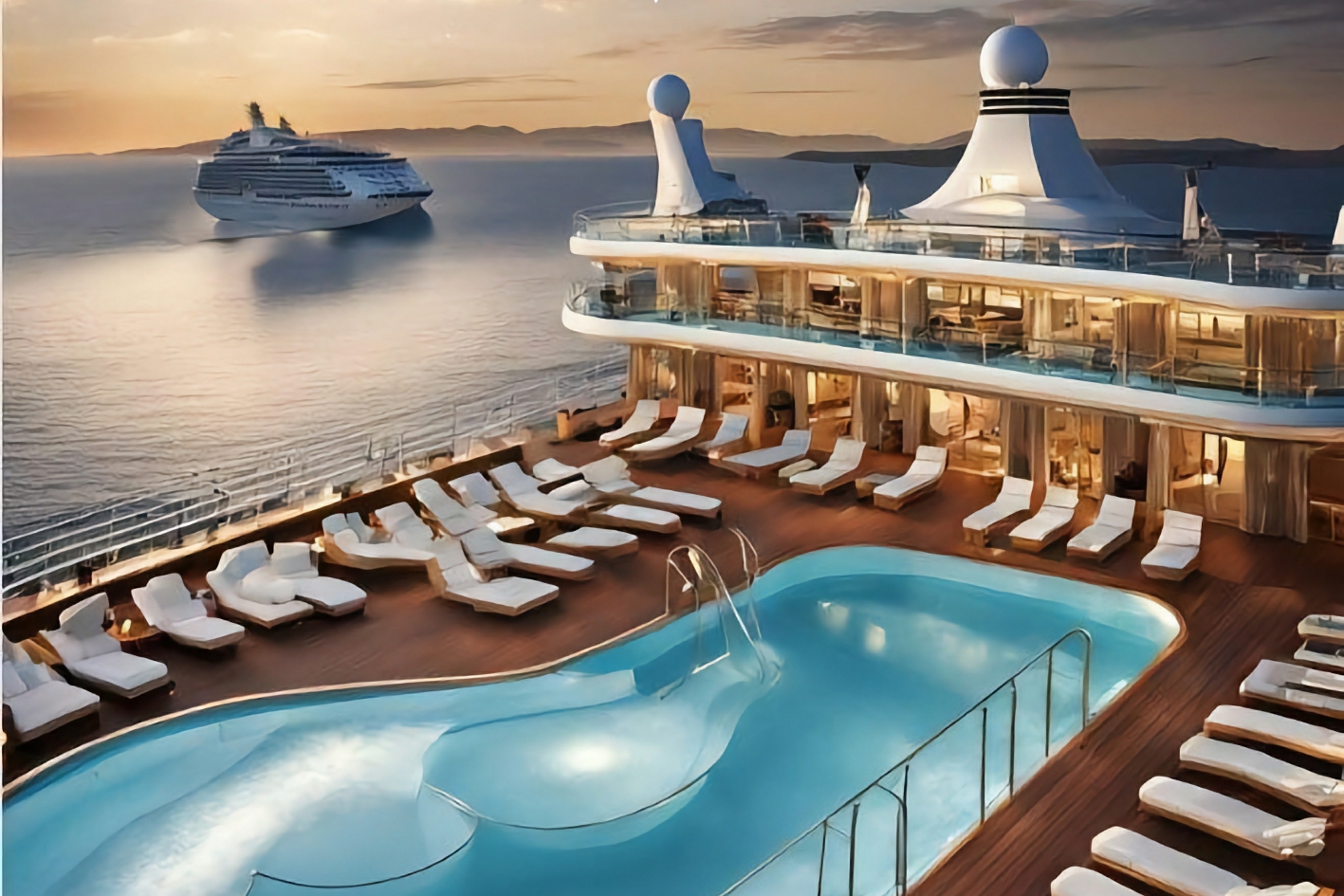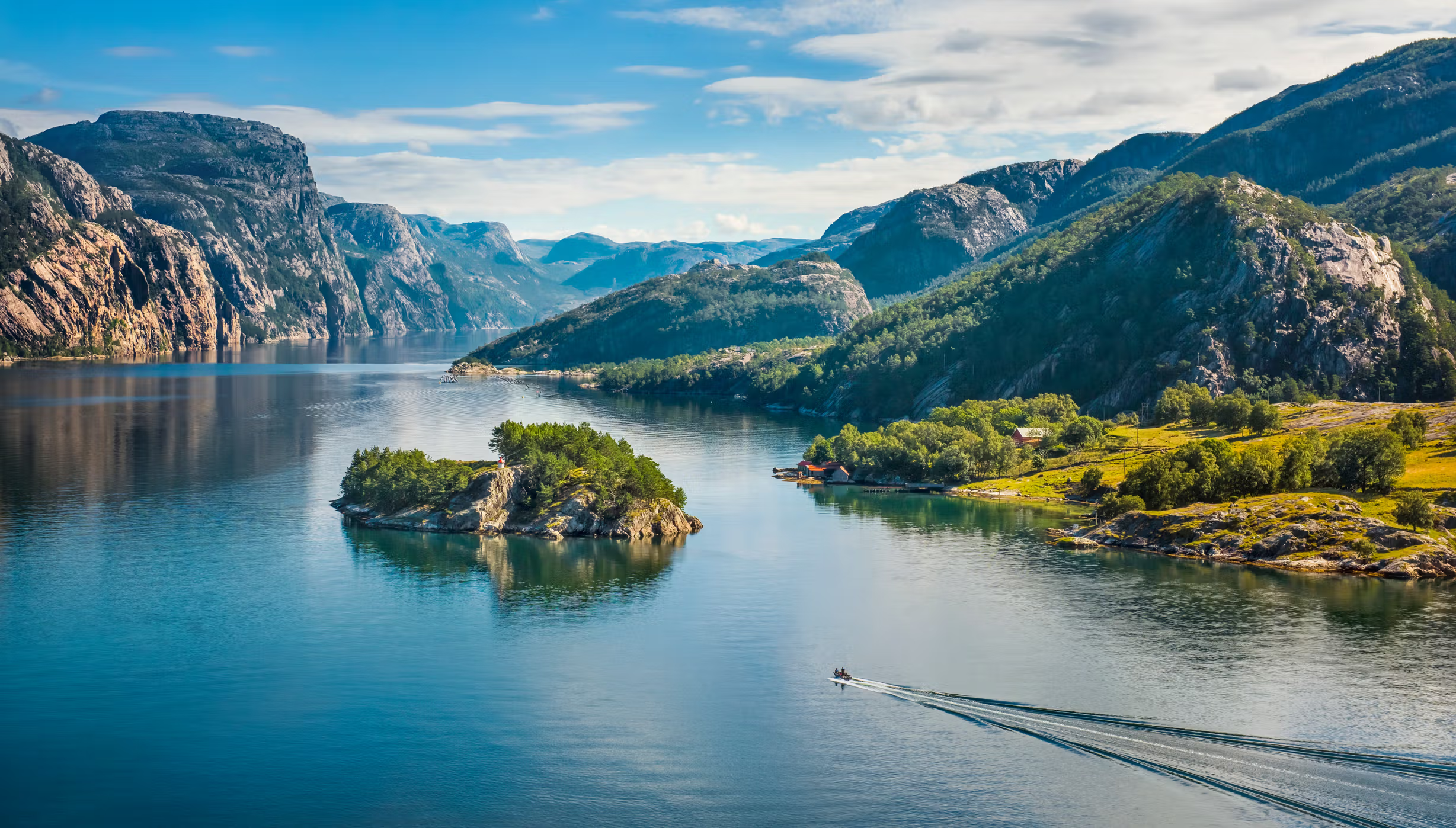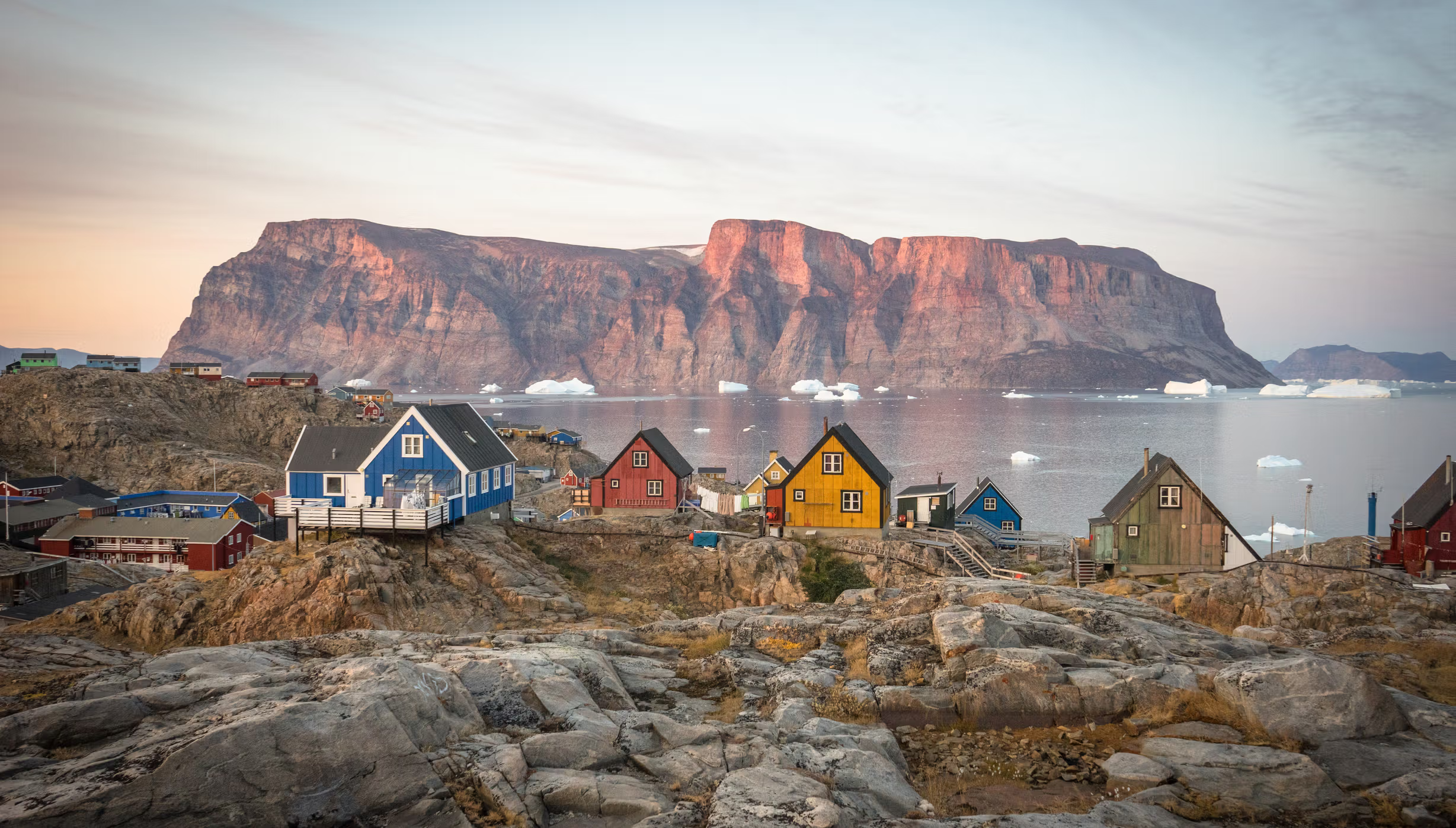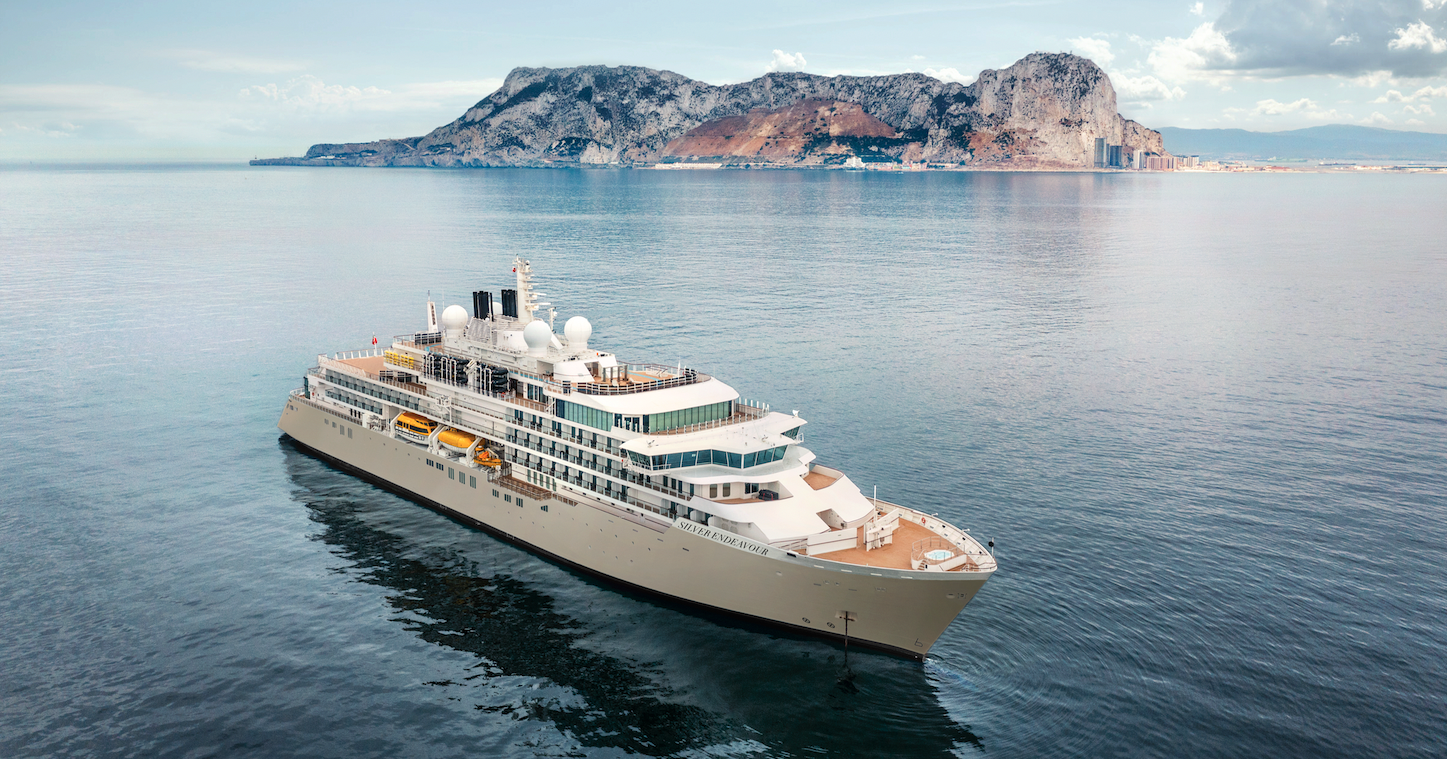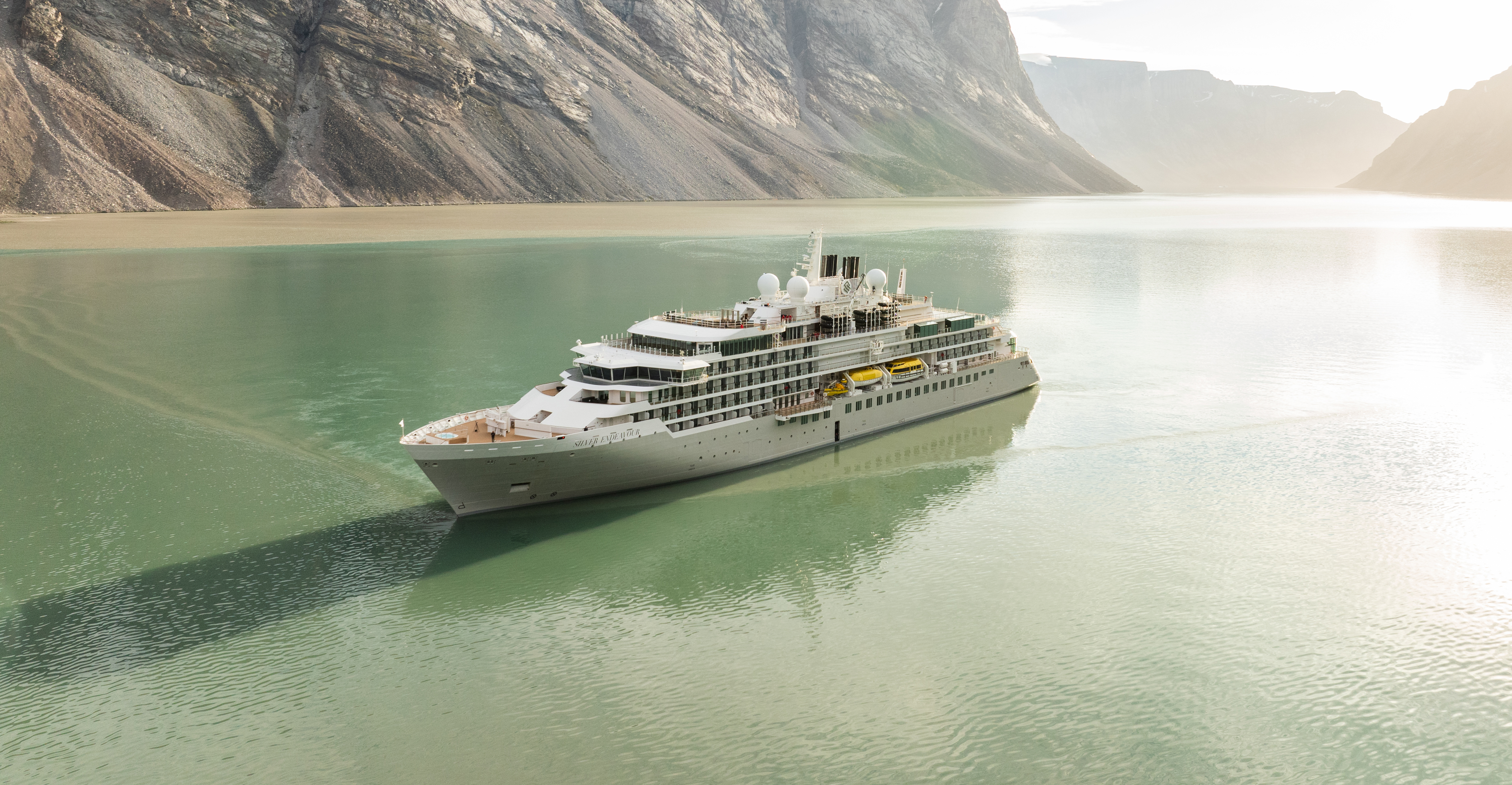Itinerary
Portsmouth is one of the most densely populated cities in Southern England, and is unusual as most of its built-up area occupies Portsea Island, linked to the mainland by road and rail bridges. Although there is a Roman fort at nearby Portchester, occupied later by the Saxons and Normans, there was no settlement on the site of Portsmouth at the time of the 1086 Domesday Book. The town developed in medieval times and received its first charter in 1194 from King Richard I; soon afterwards it became a major naval base. It has the world’s oldest dry dock, and is home to several famous ships, including HMS Victory, HMS Warrior and the Mary Rose, raised from the Solent in 1982. Portsmouth remains an important naval base and is home to a large proportion of the British service fleet. The waterfront area is now dominated by the Spinnaker Tower, 560 feet high, the United Kingdom’s tallest building outside London. Other things to see in the city include the house where Charles Dickens was born, and the City Museum, which contains a permanent exhibition devoted to another famous writer, Sir Arthur Conan Doyle, who lived in the town.
Day itinerary:
Portsmouth also known as Pompey, is home to three hugely important historic ships, HMS Victory, Nelson’s famous flagship at the battle of Trafalgar, HMS Warrior the first ironclad warship and the Mary Rose, Henry VIII’s warship that sank in the Solent just off of Southsea Castle. These are all housed at the Historic Dockyard, home of the Royal Navy and also home to the world’s first dry dock. The Historic Dockyard is one of the top ten visitor attractions in the UK. But Portsmouth is not just about history, the city is a cosmopolitan University city, with much to offer visitors and residents alike. Portsmouth has a Premier league football team, a superb seafront area, excellent shopping and a wide range of restaurants, pubs and bars. Portsmouth UK is home to the tallest publicly accessible structure in the UK, the Spinnaker Tower built right on the edge of Portsmouth Harbour at Gunwharf Quays. Portsmouth Harbour has been used in a number of films and television programmes such as Tomorrow Never Dies (James Bond), Oscar and Lucinda, Making Waves, Silent Witness, Mr Bean and Eastenders. The local area was used extensively in the filming of Tommy, The Who’s rock opera.
For many visitors Tresco is the most attractive of the Isles of Scilly. This is especially due to its Abbey Garden, which is home to thousands of exotic plant species from around 80 different countries. Plant collector Augustus Smith began the gardens in the 1830s on the site of an old Benedictine Abbey by channelling the weather up and over a network of walled enclosures built around the Priory ruins. He had three terraces carved from the rocky south slope and maximised Tresco’s mild Gulf Stream climate. Even in mid-winter there still are hundreds of plants flowering here. Another surprising attraction at the Abbey Garden is the collection of figureheads from ships that wrecked among the Isles of Scilly.
Day itinerary:
For many visitors Tresco is the most attractive of the Isles of Scilly. This is especially due to its Abbey Garden which is home to thousands of exotic plant species from around 80 different countries. Plant collector Augustus Smith began the gardens in the 1830s on the site of an old Benedictine Abbey by channelling the weather up and over a network of walled enclosures built around the Priory ruins. He had three terraces carved from the rocky south slope and maximised Tresco’s mild Gulf Stream climate. Even in mid-winter there still are hundreds of plants flowering here. Another surprising attraction at the Abbey Garden is the collection of figureheads from ships that wrecked among the Isles of Scilly.
The magnificent Skellig Islands lie 8 miles (12 km) off the coast of Portmagee in South West Kerry. Rising majestically from the sea, Skellig Michael towers 714ft. (218 metres) above sea level. On the summit of this awe-inspiring rock you will find a remarkably well preserved sixth century monastic settlement now designated a UNESCO World Heritage Site. Small Skellig is equally renowned in matters of ornithology as the home of some 27,000 pairs of gannets – the second largest colony of such seabirds in the world. The final scene of Star Wars: The Force Awakens was shot on Skellig in July 2014, with additional filming taking place there in September 2015. The remains of the Skellig Michael monastery appear in the film, representing an ancient Jedi temple. From any angle, or from any vantage point on the nearby Ring of Kerry, they are spectacular pinnacles, which have magnetised viewers throughout all history – and beyond.
Day itinerary:
If you think that the Skellig Islands look familiar, that’s because they are. The Skelling Michal towers set the scene in episodes seven and eight of the Stars Wars franchise, and local tourism has been feeling the force ever since. Aside from being in a galaxy far, far, away, the magnificent the Skellig Michael towers have been a UNESCO World Heritage Site since 1996. The two Islands were (Great Skellig and Little Skellig) were part of a Gaelic Christian Monastic settlement from the 6th to the 12th century and the towers on Skellig Michael (Great Skellig) are a “unique example of an early religious settlement” (as well as being a final resting place for Jedis). The towers are surely the main attraction of the area and are simply fascinating. Built in a beehive shape to protect against the harsh elements, they use local stone and no mortar. Today, some 1,400 years later, they are still practically intact. There is also a graveyard on the island. Although be prepared for some walking; there are 618 steps winding up to the stone summit, which can get slippery in bad weather. However, like most things that require effort, you will be rewarded once you reach the top. The breathtaking views and photo opportunities are well worth it! Little Skelling is equally as important for birders too; the island is home to almost 30,000 pairs of gannets, the second largest colony of seabirds in the world. Guillemots, Puffins, Manx Shearwaters and Storm Petrels also nest on the island, making up the “Skellig Big Five”.
Kilronan is the principal town on the island of Inismore (Inis Mór) in the Aran Islands located in Galway Bay, and is one of them most picturesque spots in Ireland. Once for the sole purpose as a fishing port for the Aran fisherman, today it is the main port for the ferry companies and with its white sandy beach it has a wide selection of first class restaurants serving seafood, and traditional Irish bars, buskers, and accommodation it is a splendid spot to people watch and a base yourself before exploring the island. One of the island’s most famous attractions is Dun Aengus. Dun Aengus is a fort situated on the edge of a cliff at a height of 100 meters overlooking the Atlantic on the Aran Islands, Inishmore. It consists of a series of concentric circular walls, the innermost; the citadel encloses an area approximately 50 meters in diameter with 4m thick walls of stone. These walls have been rebuilt to a height of 6m and have wall walks, chambers, and flights of stairs as well. The main industries in Kilronan are fishing and tourism. School children also visit to improve their Irish at summer schools. Kilronan has a population of approx. 300 people.
Day itinerary:
If you have ever wanted to imbibe in the Celtic legends of your past, then Kilronan is the answer to your prayers. Situated on the isle of Inishmore in the Aran Islands in County Galway, Cill Rónáin – the official Gaelic spelling – is all about history, spirituality and the kind of rejuvenation that can only be found on Irish soil. The first thing you should know about the Aran Isles is that they are exceptionally beautiful. National Geographic called them “one of the world’s top island destinations” and they are universally recognised as being the “islands of saints and scholars”. Windswept moors and craggy cliffs akin to a Victorian novel flank rolling seas that are Dantesque in their raw power. This is where nature comes home to roost (not to mention the 60,000 seabirds that call the islands their home). Inishmore (Inis Mor) is the biggest island of the archipelago, and as such has the most interesting Celtic history. Over 50 Celtic, Christian and pre-Christian sites are on Inishmore alone (with others on the other two islands that make up the rest of the archipelago). The most important of these site is perhaps the prehistoric fort of Dún Aonghasa, “the most magnificent barbaric monument extant in Europe”. Perched precariously on a 100-metre-high cliff, the fort dates back 3,000 years and is one of Ireland’s most ancient and sacred sites. Little is known of the history of Dún Aonghasa, not who Dún Aonghasa may have been, but a placing so close to the sea edge suggests ritualistic significance.
Killybegs The days start early in Killybegs, as this quiet fishing town rumbles to life, and ships with red and blue paint peeling from their hulls quietly depart, ready for a morning’s hard work at sea. Located in a scenic part of County Donegal, Killybegs is Ireland’s fishing capital, and the salty breeze and pretty streets serve as a revitalising medicine for visitors. The town is also your gateway to some of the country’s most majestic coastal scenery, which is dotted with flashing white lighthouses, keeping watch over invigorating seascapes. Killybegs enjoys a privileged position on the coast of north west of Ireland, close to the spectacular Slieve League – a titanic mountain, which explodes upwards from frothing ocean. Walk as close as you dare to the coastline’s sheer drops, or admire the folding cliffs from the best vantage point, down on the water.
Day itinerary:
An all-encompassing, all-Irish, genuine warm welcome awaits those who visit Killybegs. Set in the Republic of Ireland’s Wild Atlantic Way, Killibegs is a hidden gem of a town that is often overshadowed by Dublin and Galway. But, as the privileged position on the north west coast proves, Killibegs is worth discovering. Be prepared to be overwhelmed by the beauty of the area. The spectacular Slieve League Cliffs, around 45-minutes through the rolling Donegal countryside, are said to be much more dramatic than the Cliffs of Mohr, so those who want to see some of Mother Nature’s finest work will want to head straight for here. At a height of approximately 1,968 feet (about 600 metres) above sea level, the Cliffs are believed to be Europe’s highest sea cliffs, and boast an unspoilt natural landscape. Admire the views from either above, looking down on the rolling waters beyond, or from below, gazing up at the folding cliffs towering before you. Don’t forget your camera! A stroll through Killybegs is rewarding in a tranquil way. The quiet fishing village is lulled by the salty sea breeze and the streets are pretty in a way that only authentic fishing villages can be. The image of soft light bouncing off the harbour walls, reflecting on the waters is something that is truly lovely and will not be forgotten in a hurry. The little town centre is well worth a visit, and can take all day if you get chatting to a local. Cosy little pubs, white sandy beaches and a rich, local history bring up the rear.
Nestled behind lofty city walls, Londonderry is a destination of culture, which boasts an increasingly envied reputation. This Northern Irish city is still riding on the momentum of a fantastic 2013, when it was named as UK City of Culture, and singled out as one of Lonely Planet’s top 5 destinations to visit. The wonderfully preserved city walls are perhaps Londonderry’s most treasured charm, and they encircle 1,450 years of history, and are over 400 years old. The walls came to the fore of the city’s history during the Siege of Derry, back in 1688 – when King James’s forces attacked, causing mass starvation and suffering over 105 days of stalemate. It takes approximately an hour to wander the entire circuit of the walls, and see their seven gates, and you’ll absorb a feast of information along the way. View the mighty cannons that boomed during the siege, or stop into one of the plentiful cafes, should you need a little refreshment before continuing your journey. St. Columb’s Cathedral, which dates back to 1633, towers over the walled city, and is one of the city’s most significant historic sites. Its dreamy spire contains a set of bells that have peeled out melodies here since 1638, making them Ireland’s oldest.
Day itinerary:
Nestled behind lofty city walls, Londonderry is a destination of culture, which boasts an increasingly envied reputation. This Northern Irish city is still riding on the momentum of a fantastic 2013, when it was named as UK City of Culture, and singled out as one of Lonely Planet’s top 5 destinations to visit. The wonderfully preserved city walls are perhaps Londonderry’s most treasured charm, and they encircle 1,450 years of history, and are over 400 years old.The walls came to the fore of the city’s history during the Siege of Derry, back in 1688 – when King James’s forces attacked, causing mass starvation and suffering over 105 days of stalemate. It takes approximately an hour to wander the entire circuit of the walls, and see their seven gates, and you’ll absorb a feast of information along the way. View the mighty cannons that boomed during the siege, or stop into one of the plentiful cafes, should you need a little refreshment before continuing your journey. St. Columb’s Cathedral, which dates back to 1633, towers over the walled city, and is one of the city’s most significant historic sites. Its dreamy spire contains a set of bells that have peeled out melodies here since 1638, making them Ireland’s oldest.
With a population of 120 residents, Iona is Located off the Southwest of Mull. The island is 3 miles long and 1.5 miles wide but draws in thousands of visitors each year due to its natural beauty and historical interest. Saint Columba and his fellow monks landed here in 563. This beautiful stretch of coastline brings out the true beauty of Iona facing onto the Gulf Stream that gives the island its mild climate. Located to the south of the road lies Sìthean Mòr (Large fairy hill) and alternatively known as the Hill of Angels, this is said to have been the setting for many rituals and traditions dating far back in history. This wonderful highlight, Iona Abbey was founded by Saint Columba in 563 and is said to have survived many Viking attacks. Although little remains of the monastic buildings of this period, the magnificent Abbey is the main attraction.
Day itinerary:
If tiny islands that resonate with peace and tranquillity are your idea of travel heaven, then welcome to Iona. Almost 200 miles east of Edinburgh, set in Scotland’s Inner Hebrides, this magical island has a spiritual reputation that precedes it. And luckily, more than lives up to. The island is miniscule. Just three miles long and only one and a half miles wide, this is not a place that hums with urban attractions. 120 people call Iona home (this number rises significantly if the gull, tern and Kittiwake population is added), although residential numbers do go up (to a whopping 175) in summer. The beautiful coastline is lapped by the gulf stream and gives the island a warm climate with sandy beaches that look more Mediterranean than Scottish! Add to that a green field landscape that is just beautiful, and you’ll find that Iona is a place that stays with you long after you leave. Iona’s main attraction is of course its abbey. Built in 563 by Saint Columbia and his monks, the abbey is the reason why Iona is called the cradle of Christianity. Not only is the abbey (today an ecumenical church) one of the best – if not the best – example of ecclesiastical architecture dating from the Middle Ages, but it also serves as an important site of spiritual pilgrimage. St. Martin’s Cross, a 9th century Celtic cross that stands outside the abbey, is considered as the finest example of Celtic crosses in the British Isles. Rèilig Odhrain, or the cemetery, allegedly contains the remains of many Scottish kings.
The stunning Isle of Lunga is the largest island in the Treshnish archipelago. With volcanic origin the isle was populated until the 19th Century, and remains of black houses can be seen around this magnificent coastal jewel. Abundant plant life and exotic birdlife are now the main inhabitants of the area. Fortunate visitors view the magnificent array of birds, especially the great puffins that breed on the islands plateau. One can sit within just a few feet away without disturbing the avian ambassador’s peace. The 81 hectare island is home to many rare and endangered plants such as, primroses and orchids. Views over the landscape and across the ocean can be seen from the 300 foot high cliffs.
Day itinerary:
The stunning Isle of Lunga is the largest island in the Treshnish archipelago. With volcanic origin the isle was populated until the 19th Century and remains of black houses can be seen around this magnificent coastal jewel. Abundant plant life and exotic birdlife are now the main inhabitants of the area. Fortunate visitors view the magnificent array of birds especially the great puffins that breed on the islands plateau. One can sit within just a few feet away without disturbing the avian ambassador’s peace. The 81 hectare island is home to many rare and endangered plants such as primroses and orchids. Views over the landscape and across the ocean can be seen from the 300 foot high cliffs.
St Kilda is a remarkable uninhabited archipelago some 40 nautical miles beyond the Outer Hebrides. The stunning cliffs and sea stacks are home to the most important seabird breeding colony in northwest Europe. St Kilda is one of the few places in the world to have received dual World Heritage status from UNESCO in recognition of its Natural Heritage and cultural significance. Village Bay on the island of Hirta once supported a population of over 200, but the last islanders left in the 1930s. Recent restoration work on the village by the National Trust for Scotland offers a marvellous link with the past. One of the caretakers acts as shopkeeper and postmaster for any visitors who might like to send a postcard home from St. Kilda.
Day itinerary:
Gloriously remote, St. Kilda is an archipelago 50 miles off the Isle of Harris. Although the four islands are uninhabited by humans, thousands of seas birds call these craggy cliffs home, clinging to the sheer faces as if by magic. Not only is St. Kilda home to the UK’s largest colony of Atlantic Puffin (almost 1 million), but also the world largest colony Gannets nests on Boreray island and its sea stacks. The islands also home decedents of the world’s original Soay sheep as well as having a breed of eponymously named mice. The extremely rare St. Kilda wren unsurprisingly hails from St. Kilda, so birders should visit with notebook, binoculars and camera to hand. While endemic animal species is rife on the island, St. Kilda has not been peopled since 1930 after the last inhabitants voted that human life was unsustainable. However, permanent habitation had been possible in the Medieval Ages, and a vast National Trust for Scotland project to restore the dwellings is currently being undertaken. The islands even enjoyed a status as being an ideal holiday destination in the 19th century. Today, the only humans living on the islands are passionate history, science and conservation scholars. One of the caretakers even acts as shopkeeper and postmaster for any visitors who might like to send a postcard home from St. Kilda. It should be noted that St. Kilda is the UKs only (and just one of 39 in the world) dual World Heritage status from UNESCO in recognition of its Natural Heritage and cultural significance.
Day itinerary:
As an isolated island of the remote St Kilda Group, Boreray island is one of the most far flung and weather impacted islands of the North East Atlantic. Imagine trying to live here during stormy weather. Landing requires jumping or swimming ashore; and yet the island has been lived on or visited from Neolithic times. Collecting seabirds and their eggs, and storing them for winter, may have been even more important than raising sheep. Boreray Sheep are the rarest breed of sheep in Britain. They evolved from short-tailed sheep brought from the Scottish mainland but have been isolated long enough to have evolved into a distinctive small and horned breed. Only found on Boreray Island, they remained as a wild flock when the last people left the St Kilda Islands in 1930. The Souy are a separate and different breed of sheep found on the other St Kilda Islands. Look out for the Boreray Sheep grazing on the slopes of hilly Boreray Island. Seabirds thrive on Boreray and its two attendant rocks stacks, raising new chicks each summer. Northern Gannets glide overhead as they attempt difficult landings at nest sites. Seeing gannets plunge from a great height into the sea is an exciting way to understand the effort required to feed themselves and chicks. Northern Fulmers nest on the volcanic rock cliffs and Atlantic Puffins fly in and out of burrow-strewn slopes. Boreray is part of the St Kilda World Heritage Site, a rare example of a site recognised for both its outstanding natural and cultural values.
Day itinerary:
Cliffs of tall hexagonal columns create a sensational landscape at the Shiant Islands, especially when viewed from the sea. The cliffs of six-sided rock columns look like the cross-section of an enormous honeycomb. The rock formations were formed when molten volcanic magma cooled very slowly underground. Millions of years of erosion has exposed the six-sided columns to the sea, and to us. The tallest of these formations is 120 metres (390 feet) high. During spring and summer, flights of seabirds near the Shiant Islands catch the eye. Many long-winged seabirds wheel and soar gracefully. Others are more shaped for underwater swimming and fly in direct lines, beating stubby wings to resemble flying potatoes. Some birds nest in burrows while others, like Black-legged Kittiwakes, nest on cliffs. Rather than build nests, guillemots lay eggs on bare rock ledges. The pointed shape of the eggs ensures they roll in a tight circle, not off the ledge to the sea below. The Shiant Islands are part of the Outer Hebrides and located between the Isles of Lewis and Skye. Historically, they have supported families of sheep grazers who could tolerate a lonely island outpost. The Shiants were known as the last place in Britain where the Black Rat occurred in substantial numbers. Originally introduced to Britain from Asia in Roman times these rodents caused problems, eating eggs and chicks of seabirds. A successful eradication program eliminated the rats in 2016, giving the seabird colonies well-earned peace.
Day itinerary:
Rise to the heights of the craggy outcrop of Arthur’s Seat, the greatest of the seven mountains surrounding Edinburgh, to survey one of the world’s most magical cities from a truly privileged outlook. Few cities can genuinely claim to have it all, but Edinburgh may be one, with its immense artistry, gorgeous architecture and deep contribution to high culture. A cultural, creative and curious place it may be, but the locals are anything but superior, and many a friendly chat and ribbing takes place in the nooks of its flower-draped pubs. Open parks, and the majestic Royal Botanic Gardens – open since 1670 – offer more colour among the wash of pretty Georgian and brick buildings. With such architectural and artistic wealth, it’s no surprise that Edinburgh continues to be a city of literature, where the written word is revered above all else. The looming memorial dedicated to Sir Walter Scott symbolises this and is one of the world’s largest monuments dedicated to a writer. The Writers’ Museum is dedicated to the craft of other Scottish wordsmiths, such as Sir Robert Burns and Robert Louis Stevenson. The old town is a quaint and enchanting place, and Edinburgh’s storied literary heritage continues to grow, with J.K. Rowling formulating Harry Potter’s magical world in the cute cafes here. Wander the bustling, gas-lamp-lit cobbled streets, and sink into a fairy-tale world of your own, before ascending to Edinburgh Castle – which rises majestically above the city on its volcanic plug perch.
Ship features
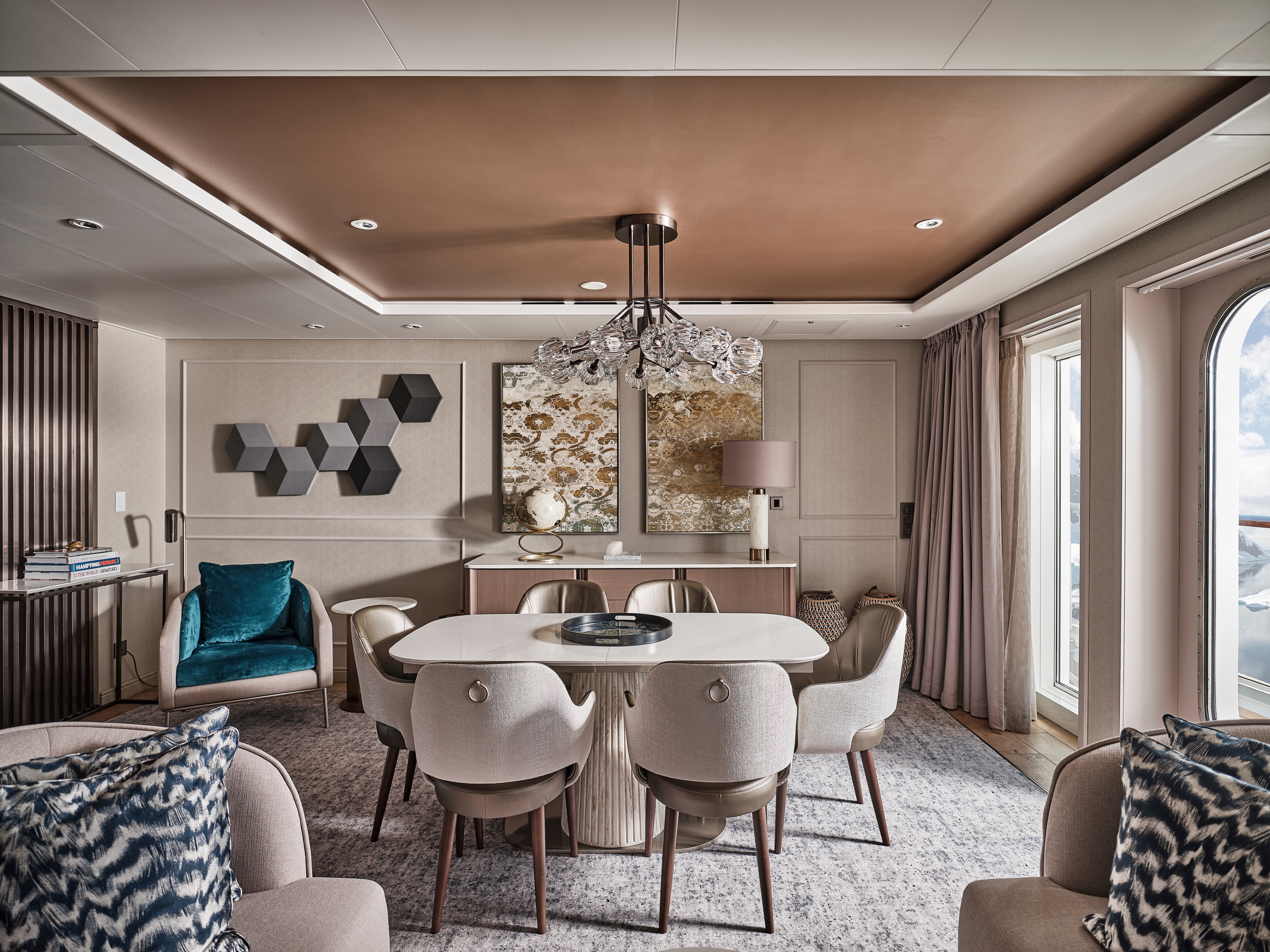
Owner’s Suite
Supremely spacious and superbly located, the Owner’s Suite is the most luxurious suite on board. Located in the premium bow position on deck 7, the Owner’s Suite offers amazing destination immersion, thanks its enormous surrounding balcony and incredible views from all indoor areas. The large living room, separate dining area, and well-stocked bar are perfect for sharing a moment with like-minded travelers while the luxurious and well-appointed bedrooms ensure supreme comfort any time of the day or night.
One bedroom: 173.5 sq m including veranda (69 sq m)
The main bedroom has a large walk-in wardrobe with a personal safe and a bathroom with a double vanity, walk-in shower, and whirlpool bath.
The second bedroom has a separate wardrobe and a bathroom with a walk-in shower.
Images are intended as a general reference. Features, materials, finishes and layout may be different than shown.
Essentials
- Deck(s): 7
- Section: Forward, Starboard
Characteristics
- Large Veranda with floor-to-ceiling glass doors
- Separate dining area
- Living room with sitting area
- Double vanity
- Walk-in shower
- Whirlpool bath
- Walk-in wardrobe with personal safe
Furniture
- Twin beds or king-size bed
- Writing desk
- Luxury bed mattresses
Media & Communication
- Unlimited Premium Wi-Fi
- 3 large flat screen TVs with Interactive Media Library
- Sound system with bluetooth connectivity
- Direct dial telephone
- Wall mounted USB-C mobile device chargers
Onboard Services
- Butler service
- Complimentary laundry, pressing & wet cleaning
- Dinner for two in La Dame, one evening per voyage,
- Two hours of worldwide phone use, per voyage segment
- Champagne on arrival
Amenities
- Espresso machine
- Pillow menu
- Refrigerator and bar setup stocked with your preferences
- Plush bathrobe
- Luxury bath amenities
- Umbrella
- Hair Dryer
- Slippers
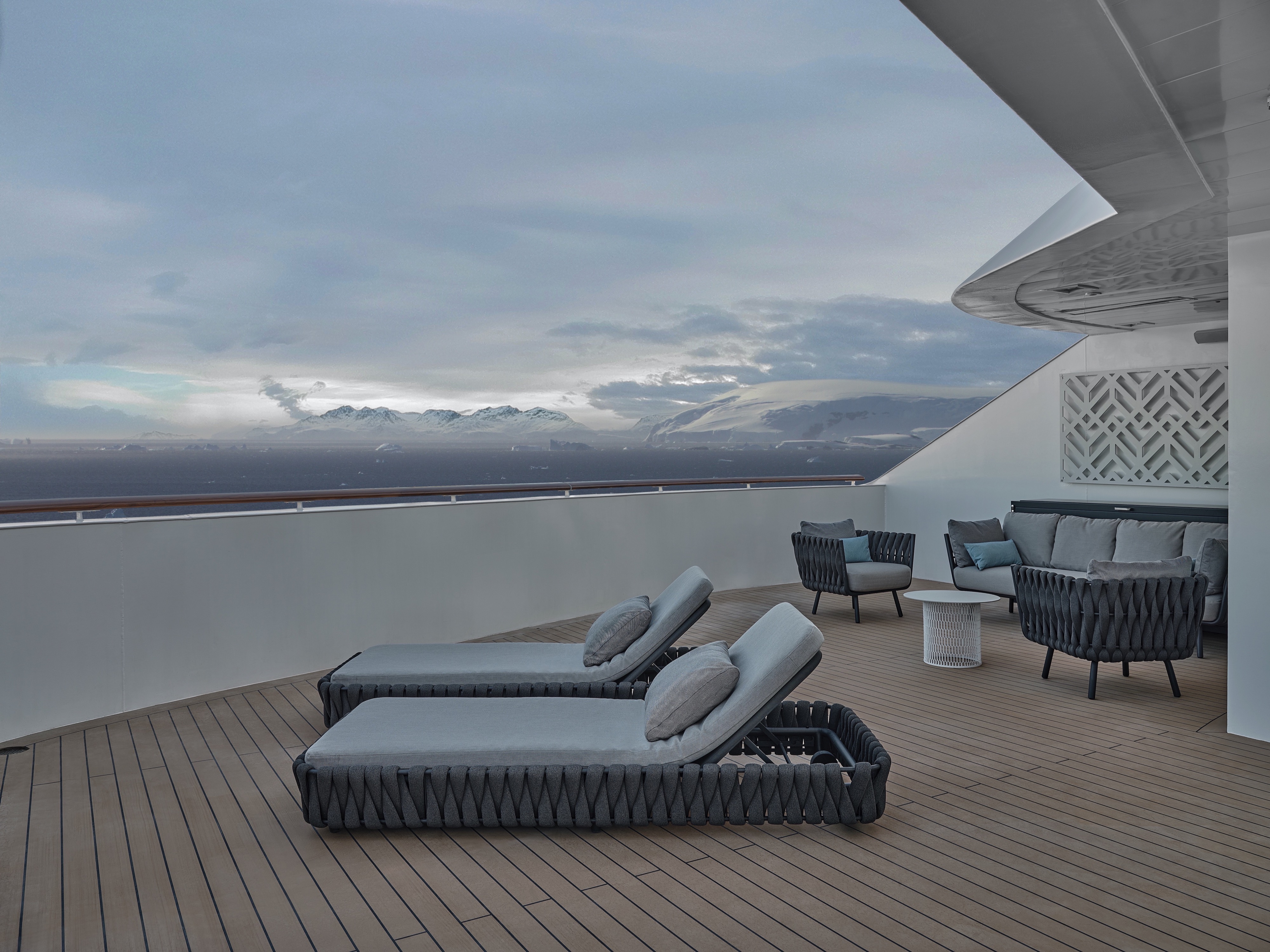
Grand Suite
The Grand Suite is one of the most luxurious and spacious suites on board Silver Endeavour. It guarantees sweeping views of your destination thanks to its large balcony. A spacious interior includes a large living room, separate dining area, and large bedroom with a big walk-in wardrobe. A luxurious bathroom includes a double vanity, whirlpool bath, and walk-in shower. In addition, the Grand Suite also includes a small, second bedroom able to accommodate a third berth.
One bedroom: 155 sq m including veranda (64 sq m)
Two bedrooms: 188.1 sq m including veranda (69 sq m)
A third guest can be accommodated in an additional single-bed bedroom.
Images are intended as a general reference. Features, materials, finishes and layout may be different than shown.
Essentials
- Deck(s): 7
- Section: Forward, Port
Characteristics
- Large Veranda with floor-to-ceiling glass doors
- Separate dining area
- Living room with sitting area
- Double vanity
- Walk-in shower
- Whirlpool bath
- Walk-in wardrobe with personal safe
Furniture
- Twin beds or king-size bed and a single bed in additional bedroom
- Writing desk
- Vanity table
- Luxury bed mattresses
Media & Communication
- Unlimited Premium Wi-Fi
- 2 large flat screen TVs with Interactive Media Library
- Sound system with bluetooth connectivity
- Direct dial telephone
- Wall mounted USB-C mobile device chargers
Onboard Services
- Butler service
- Complimentary laundry, pressing & wet cleaning
- Dinner for two in La Dame, one evening per voyage,
- Two hours of worldwide phone use, per voyage segment
- Champagne on arrival
Amenities
- Espresso machine
- Pillow menu
- Refrigerator and bar setup stocked with your preferences
- Plush bathrobe
- Luxury bath amenities
- Umbrella
- Hair Dryer
- Slippers
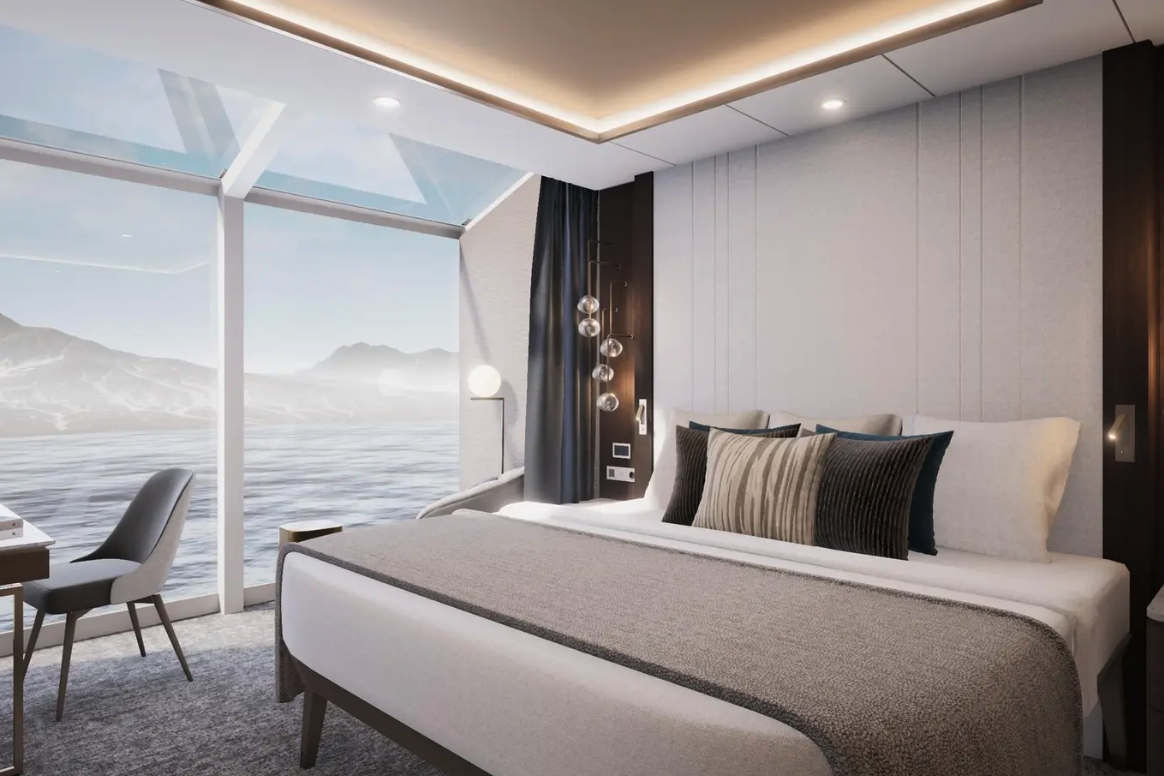
Master Suite
One of our most sumptuous suites ever designed! With innovative domed glazing surrounding the living areas and one of the largest balconies on board, the Master Suite offers complete destination immersion at sea. Floor-to-ceiling windows provide wow-factor 270-degree views while the beautifully appointed living and dining areas, separate bedroom, and bathroom with walk-in shower and whirlpool bath ensure complete in-suite comfort. If you have ever wanted to experience expedition travel while not missing out on luxury, Silver Endeavour’s Master Suite is the answer.
One bedroom: 108 sq m including veranda (25.8 sq m)
Images are intended as a general reference. Features, materials, finishes and layout may be different than shown.
Essentials
- Deck(s): 8
- Section: Aft
Characteristics
- Large Veranda with floor-to-ceiling glass doors
- Separate dining area
- Living room with sitting area
- Double vanity
- Walk-in shower
- Whirlpool bath
- Walk-in wardrobe with personal safe
Furniture
- King size bed
- Writing desk
- Luxury bed mattresses
Media & Communication
- Unlimited Premium Wi-Fi
- 2 large flat screen TVs with Interactive Media Library
- Sound system with bluetooth connectivity
- Direct dial telephone
- Wall mounted USB-C mobile device chargers
Onboard Services
- Butler service
- Complimentary laundry, pressing & wet cleaning
- Two hours of worldwide phone use, per voyage segment
- Champagne on arrival
Amenities
- Espresso machine
- Pillow menu
- Refrigerator and bar setup stocked with your preferences
- Plush bathrobe
- Luxury bath amenities
- Umbrella
- Hair Dryer
- Slippers

Signature Suite
Get closer to your destination with Silver Endeavour’s Signature Suite! Located on deck 8, this beautiful accommodation offers a wonderfully large living room, a dining area, a separate bedroom, and a bathroom with walk-in shower and whirlpool bath. But surely the best thing about the Signature Suite is the huge private veranda and floor-to-ceiling glass walls, offering you sweeping views whether you are at the tip or toe of the world. The Signature Suite is one of our favorite places to enjoy serene polar landscapes after a day of onshore exploring.
One bedroom: 67–78 sq m including veranda (16–22 sq m )
Images are intended as a general reference. Features, materials, finishes and layout may be different than shown.
Essentials
- Deck(s): 8
- Section: Aft, Mid-Ship
Characteristics
- Large Veranda with floor-to-ceiling glass doors
- Separate dining area
- Living room with sitting area
- Double vanity
- Walk-in shower
- Whirlpool bath
- Walk-in wardrobe with personal safe
Furniture
- King size bed
- Writing desk
- Luxury bed mattresses
Media & Communication
- Unlimited Premium Wi-Fi
- 2 large flat screen TVs with Interactive Media Library
- Sound system with bluetooth connectivity
- Direct dial telephone
- Wall mounted USB-C mobile device chargers
Onboard Services
- Butler service
- Complimentary laundry, pressing & wet cleaning
- Two hours of worldwide phone use, per voyage segment
- Champagne on arrival
Amenities
- Espresso machine
- Pillow menu
- Refrigerator and bar setup stocked with your preferences
- Plush bathrobe
- Luxury bath amenities
- Umbrella
- Hair Dryer
- Slippers
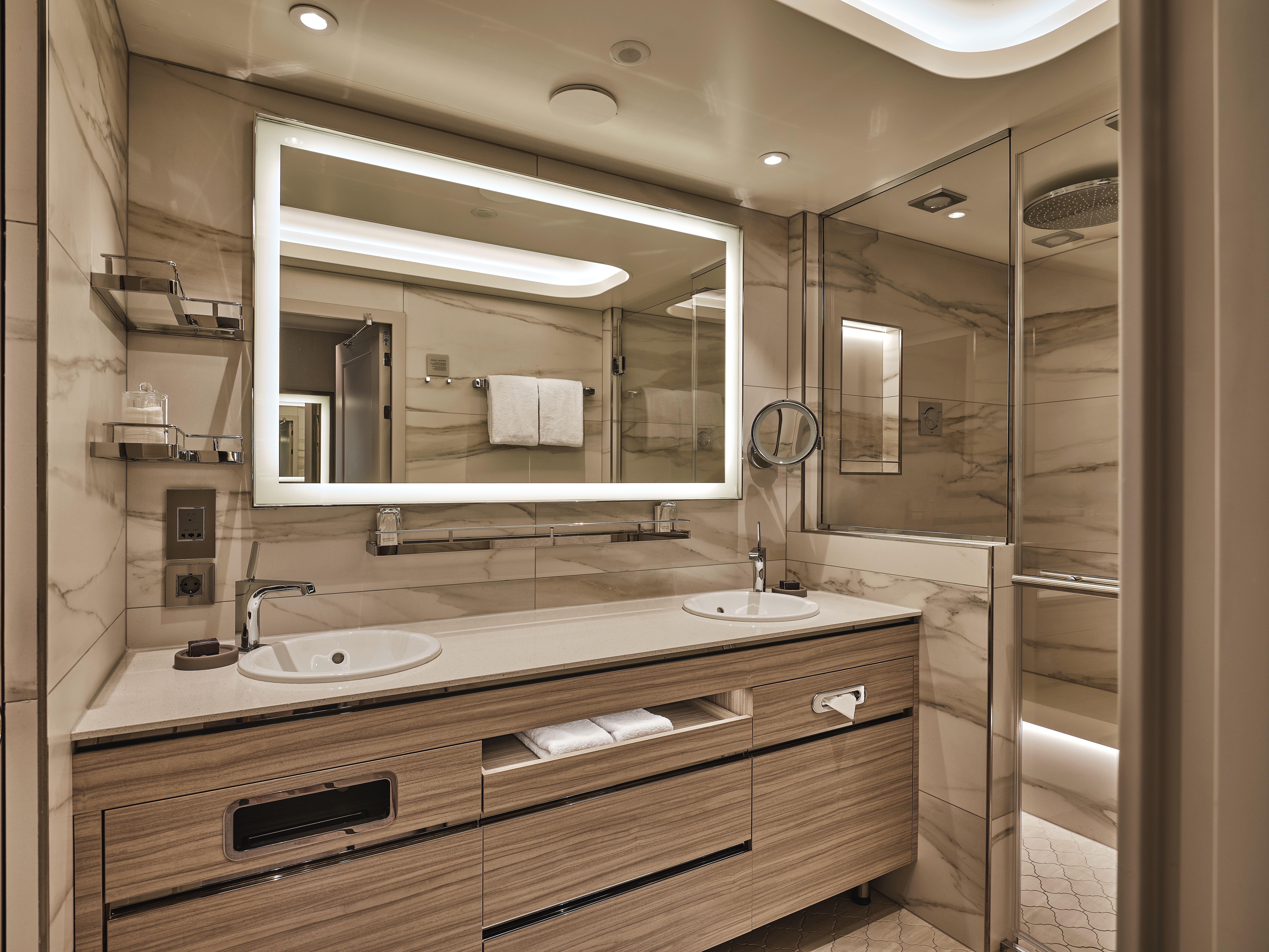
Silver Suite
No Silversea ship would be complete without our guests’ favorite Silver Suite. Located on deck 8, the Silver Suite promises stunning views of the destination thanks to its floor-to-ceiling window and large balcony. The spacious living area allows for comfortable relaxation while the dining area makes cozy nights in veritable experiences in themselves. Additionally, Silver Suites feature generous walk-in wardrobes as well as a bathroom with a large walk-in shower, vanity, and separate lavatory.
One bedroom: 49.7 sq m including veranda (7 sq m)
Please note that the third guest will sleep on a comfortable sofa bed in the reception area of the suite.
Images are intended as a general reference. Features, materials, finishes and layout may be different than shown.
Essentials
- Deck(s): 8
- Section: Mid-Ship
Characteristics
- Veranda
- Separate dining area
- Living room with sitting area
- Double vanity
- Walk-in shower
Furniture
- Writing desk
- Vanity table
- Luxury bed mattresses
Media & Communication
- Unlimited Premium Wi-Fi
- 2 large flat screen TVs with Interactive Media Library
- Sound system with bluetooth connectivity
- Direct dial telephone
- Wall mounted USB-C mobile device chargers
Onboard Services
- Butler service
- Complimentary laundry, pressing & wet cleaning
- Champagne on arrival
Amenities
- Espresso machine
- Pillow menu
- Refrigerator and bar setup stocked with your preferences
- Plush bathrobe
- Luxury bath amenities
- Umbrella
- Hair Dryer
- Slippers

Premium Veranda Suite
Our best-selling Premium Veranda Suite is more beautiful and luxurious than ever on board Silver Endeavour. This suite offers a large bedroom space with dreamy bedding, a stunning marbled bathroom with a large vanity, and sumptuous walk-in shower. Comfortable furnishings and elegant decor make staying in (almost) as good as going out! Spacious and well-situated, enjoy ultra-luxury amenities from the 24-hour butler service to the well-stocked mini-bar (and yes, they’re all included!). The sofa bed can easily accommodate a third guest.
One bedroom: 33.1 sq m including veranda (5 sq m)
Please note that the third guest will sleep on a comfortable sofa bed in the reception area of the suite.
Images are intended as a general reference. Features, materials, finishes and layout may be different than shown.
Essentials
- Deck(s): 6, 7
- Section: Forward, Mid-Ship
Characteristics
- Veranda
- Sitting area
- Large vanity
- Walk-in shower
Furniture
- King size bed
- Writing desk
- Vanity table
- Luxury bed mattresses
Media & Communication
- Unlimited Standard Wi-Fi
- 1 large flat screen TV with Interactive Media Library
- Direct dial telephone
- Wall mounted USB-C mobile device chargers
Onboard Services
- Butler service
- Champagne on arrival
Amenities
- Pillow menu
- Refrigerator and bar setup stocked with your preferences
- Plush bathrobe
- Luxury bath amenities
- Umbrella
- Hair Dryer
- Slippers
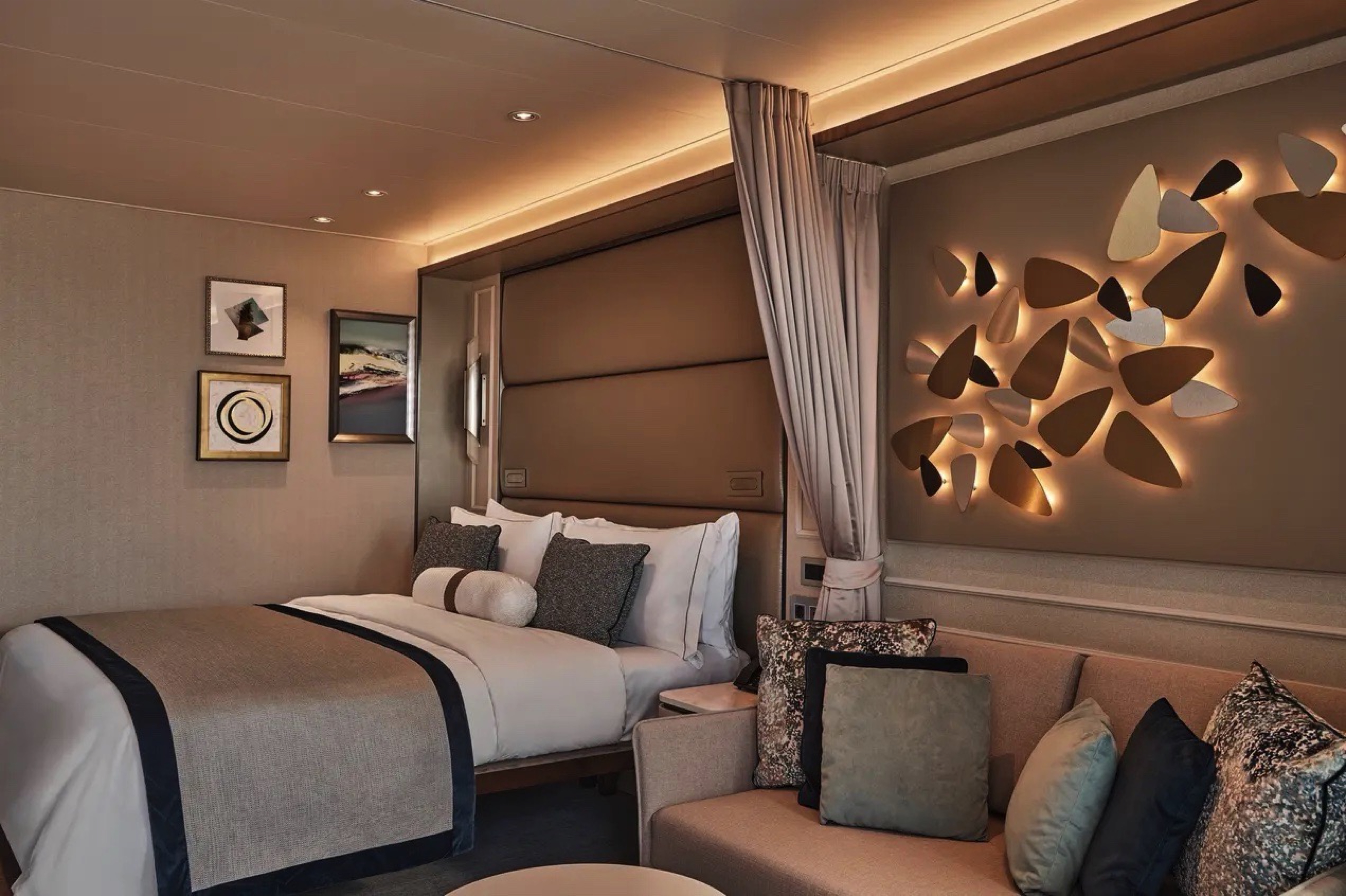
Deluxe Veranda Suite
Deluxe Veranda Suites keep the iconic suite configuration—one of the most successful in the industry—while enhancing your creature comforts and destination immersion. Located on the privileged upper-mid levels, Deluxe Veranda Suites have spacious interiors with a bedroom area that includes a large writing desk and comfortable living room with a convertible sofa (able to accommodate a third berth). Even better, the balcony is larger and more beautiful than ever, offering ample space to relax and enjoy sweeping views, wherever you are.
One bedroom: 33.1 sq m including veranda (5 sq m)
Please note that the third guest will sleep on a comfortable sofa bed in the reception area of the suite.
Images are intended as a general reference. Features, materials, finishes and layout may be different than shown.
Essentials
- Deck(s): 6, 7
- Section: Aft, Mid-Ship
Characteristics
- Veranda
- Sitting area
- Large vanity
- Walk-in shower
Furniture
- King size bed
- Writing desk
- Vanity table
- Luxury bed mattresses
Media & Communication
- Unlimited Standard Wi-Fi
- 1 large flat screen TV with Interactive Media Library
- Direct dial telephone
- Wall mounted USB-C mobile device chargers
Onboard Services
- Butler service
- Champagne on arrival
Amenities
- Pillow menu
- Refrigerator and bar setup stocked with your preferences
- Plush bathrobe
- Luxury bath amenities
- Umbrella
- Hair Dryer
- Slippers
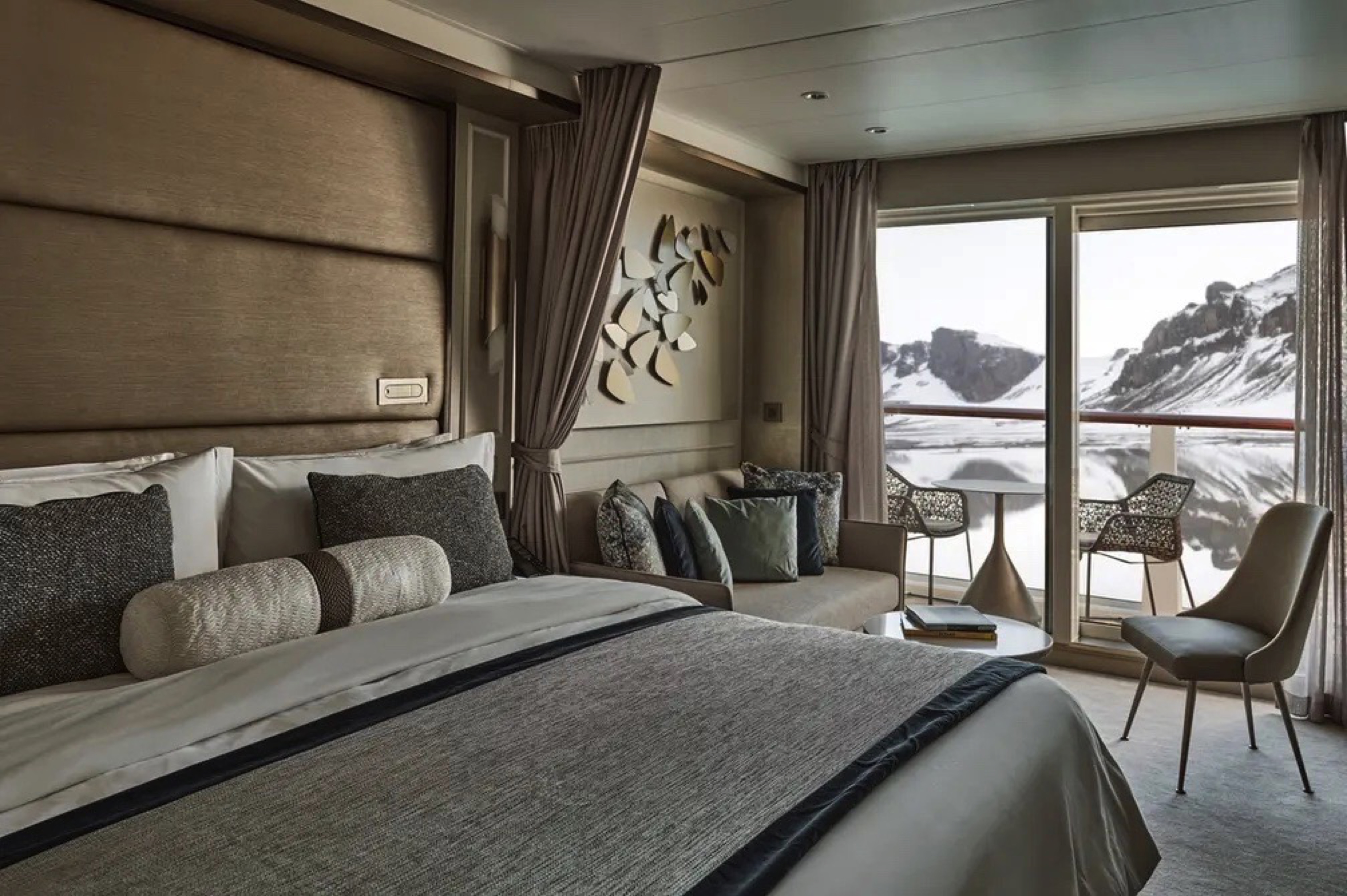
Superior Veranda Suite
The Superior Veranda Suite is found on the upper decks. From the sumptuous views from the teak veranda to the spacious sitting room (with a sofa bed able to accommodate a third berth) and large marble bathroom, everything about the Superior Veranda has been designed for your comfort. A comfortable living space, attention to detail, and a generous expanse of amenities make this stunning suite a cozy home while on the seas.
One bedroom: 33.1 sq m including veranda (5 sq m)
Please note that the third guest will sleep on a comfortable sofa bed in the reception area of the suite.
Images are intended as a general reference. Features, materials, finishes and layout may be different than shown.
Essentials
- Deck(s): 6, 7, 8
- Section: Aft, Forward, Mid-Ship
Characteristics
- Veranda
- Sitting area
- Large vanity
- Walk-in shower
Furniture
- King size bed
- Writing desk
- Vanity table
- Luxury bed mattresses
Media & Communication
- Unlimited Standard Wi-Fi
- 1 large flat screen TV with Interactive Media Library
- Direct dial telephone
- Wall mounted USB-C mobile device chargers
Onboard Services
- Butler service
- Champagne on arrival
Amenities
- Pillow menu
- Refrigerator and bar setup stocked with your preferences
- Plush bathrobe
- Luxury bath amenities
- Umbrella
- Hair Dryer
- Slippers

Classic Veranda Suite
Located on the lower decks in the bow, the Classic Veranda Suite offers all the comfort and attention to detail that you can expect aboard—both inside and out. A generous expanse of interior comforts—elegant decor, a stunning marble bathroom, and ample seating area (with a sofa bed that is able to accommodate a third berth)—offers everything you need for a comfortable cruise. But perhaps this suite’s finest asset lies just outside, as floor-to-ceiling glass doors open onto a private veranda, making every sunset feel as if it is yours alone.
One bedroom: 33.1 sq m including veranda (5 sq m)
Wheelchair accessible suite: 508. The suite has a bathroom with vanity and shower.
Please note that the third guest will sleep on a comfortable sofa bed in the reception area of the suite.
Images are intended as a general reference. Features, materials, finishes and layout may be different than shown.
Essentials
- Deck(s): 5, 6
- Section: Forward, Mid-Ship
Characteristics
- Veranda
- Sitting area
- Large vanity
- Walk-in shower
Furniture
- King size bed
- Writing desk
- Vanity table
- Luxury bed mattresses
Media & Communication
- Unlimited Standard Wi-Fi
- 1 large flat screen TV with Interactive Media Library
- Direct dial telephone
- Wall mounted USB-C mobile device chargers
Onboard Services
- Butler service
- Champagne on arrival
Amenities
- Pillow menu
- Refrigerator and bar setup stocked with your preferences
- Plush bathrobe
- Luxury bath amenities
- Umbrella
- Hair Dryer
- Slippers
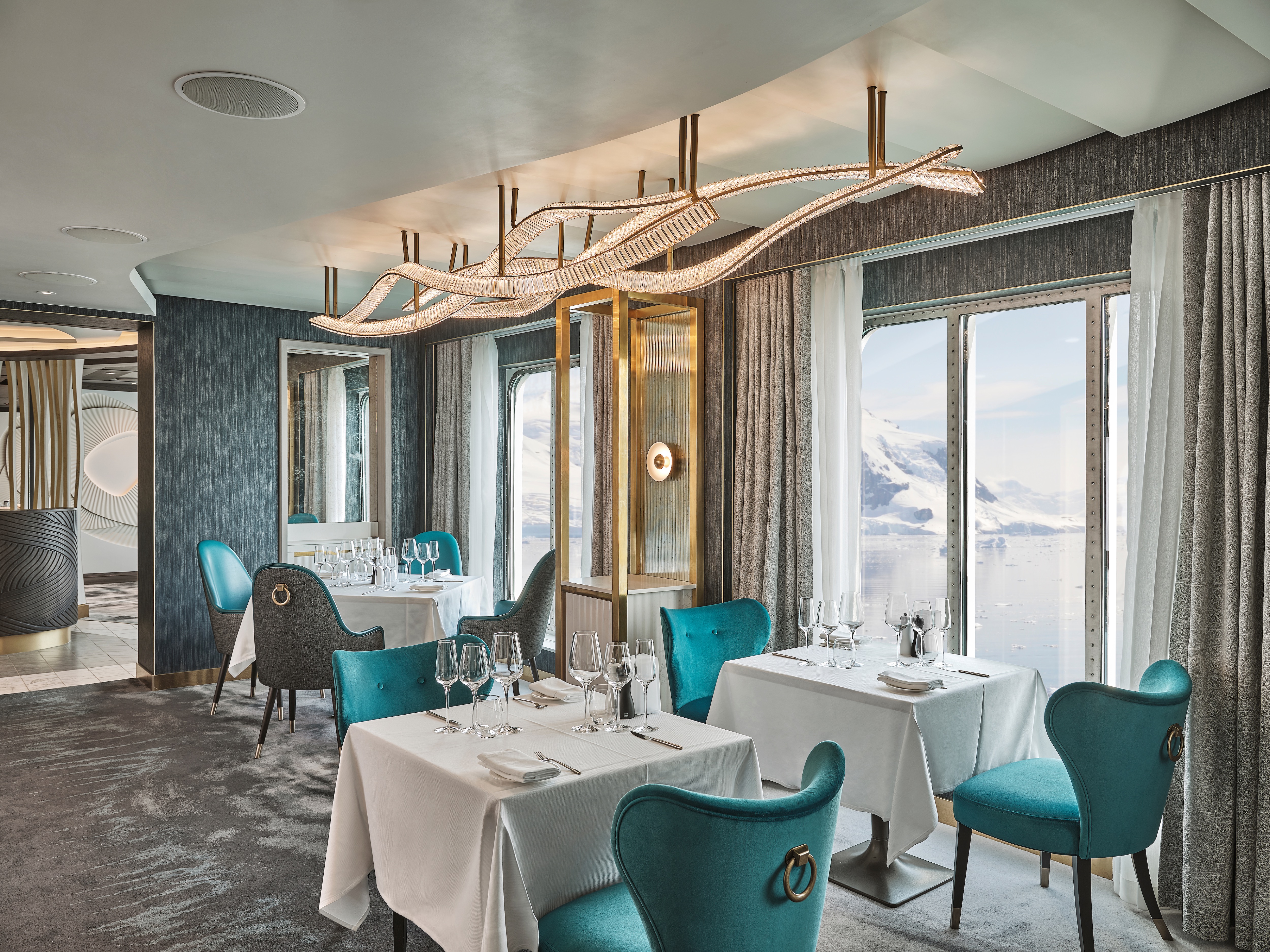
II Terrazzino
Italy’s world-famous cuisine reaches its farthest clientele yet aboard Silver Endeavour. Enjoy the country’s greatest dishes and authentic recipes in this edited version of our famous La Terrazza concept. Small in size but not in flavors, Il Terrazzino offers mouthwatering Italian meals in an elegant setting. Menu highlights change on a regular basis but always feature high-quality, fresh ingredients, which have made this dining option so popular throughout our entire fleet. If you like authentic Italian dishes served in a small and intimate setting, then Il Terrazzino is for you.
Images are intended as a general reference. Features, materials, finishes and layout may be different than shown.
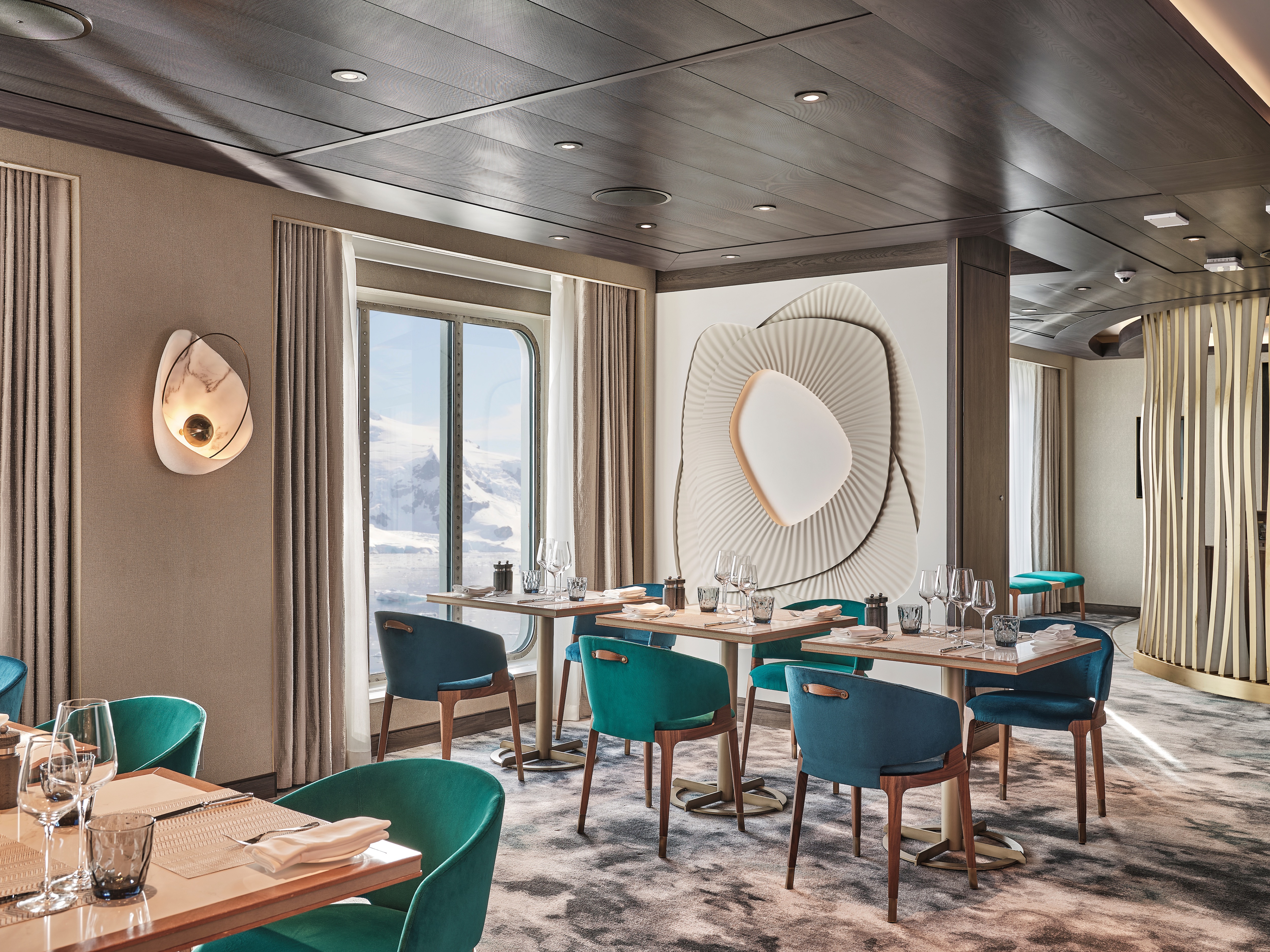
The Restaurant
Silver Endeavour’s main dining experience weaves a sensorial tapestry of tasty memories. We promise you’ll love this remarkable venue, from the timeless decor and the warm, elegant ambience to the exceptional wine selection and the subtle, refined dishes. Enjoy regional specialties whether you’re at the tip or toe of the world, along with timeless classics that never go out of fashion. The Restaurant offers open-seating dining, which means there are no assigned times, no assigned tables. You are free to dine when, where, and with whom you please.
Images are intended as a general reference. Features, materials, finishes and layout may be different than shown.
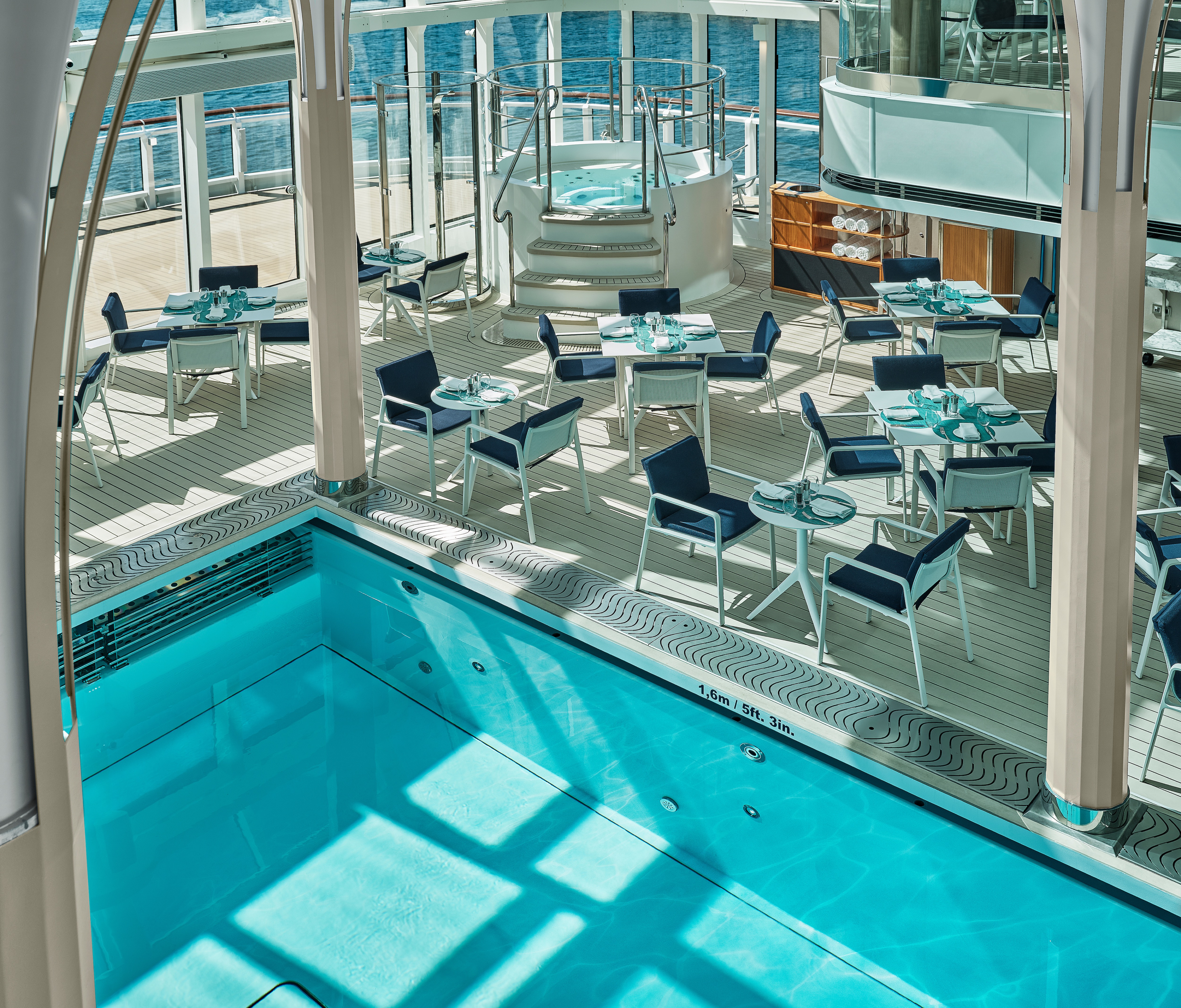
The Grill
Welcome to one of the most impressive dining rooms at sea. The Grill aboard Silver Endeavour puts the amaze into amazing. Admire impressive views from day to night as snowy landscapes give way to starlit skies. This glass-ceilinged indoor venue offers flavorsome international meals cooked to perfection in a casual, informal atmosphere. This must-visit venue is always a favorite, whatever time of the day you dine. No jacket required!
Images are intended as a general reference. Features, materials, finishes and layout may be different than shown.
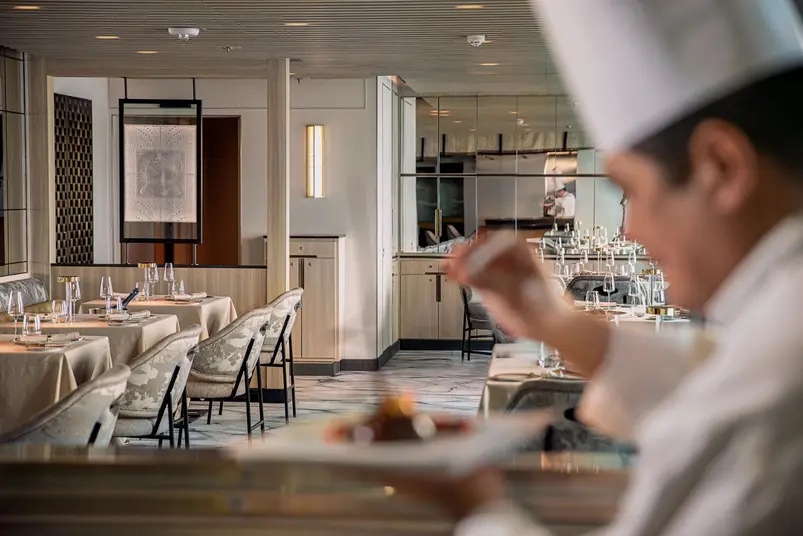
La Dame
Prepare your taste buds for one of the best gastronomic experiences you’ll probably ever have. La Dame—named after Paris’ grande dame, the Eiffel Tower—pays homage to France’s cultural and gastronomic heritage. This fine-dining experience comes complete with white-gloved service, phenomenal food, and elegant surroundings. Choose from the à la carte menu or enjoy the perfectly balanced six-course food and wine pairing menu. Whatever you decide, you’ll be gazing upon glaciers and icebergs from the stupendous floor-to-ceiling windows while sipping ice-cold champagne and dining on fresh caviar. And it’s only in La Dame, aboard Silver Endeavour.
Images are intended as a general reference. Features, materials, finishes and layout may be different than shown.
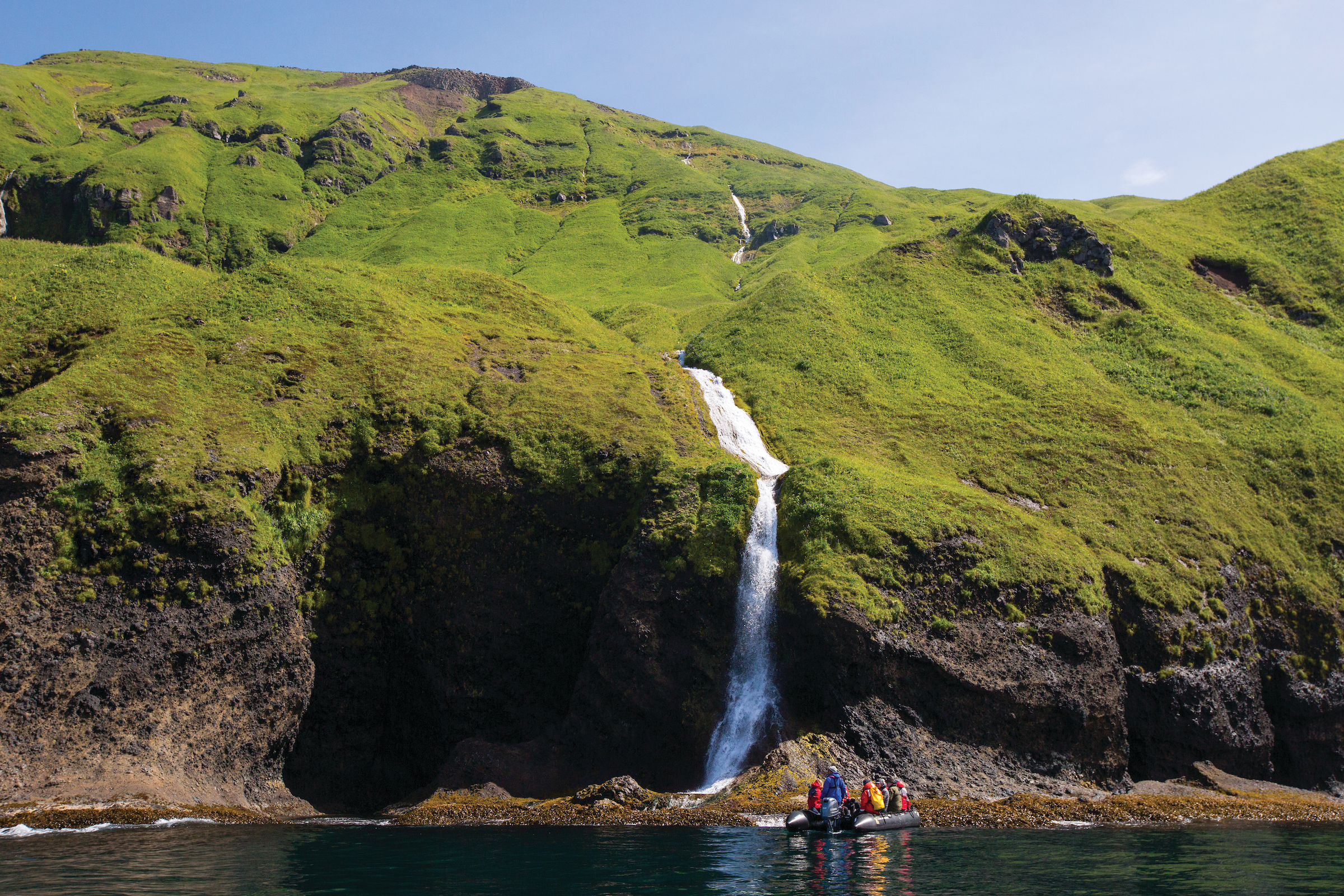
Shore Excursions
Silversea’s experienced Shore Concierge team are happy to assist, ensuring your shore-side experience is nothing less than a memory that lasts forever. Their knowledge and understanding of ports will truly add to your enjoyment and experience. Detailing history, local flavor, culture, regional customs, shopping tips and much more, they will make sure you experience the best your destination has to offer, wherever you are in the world.
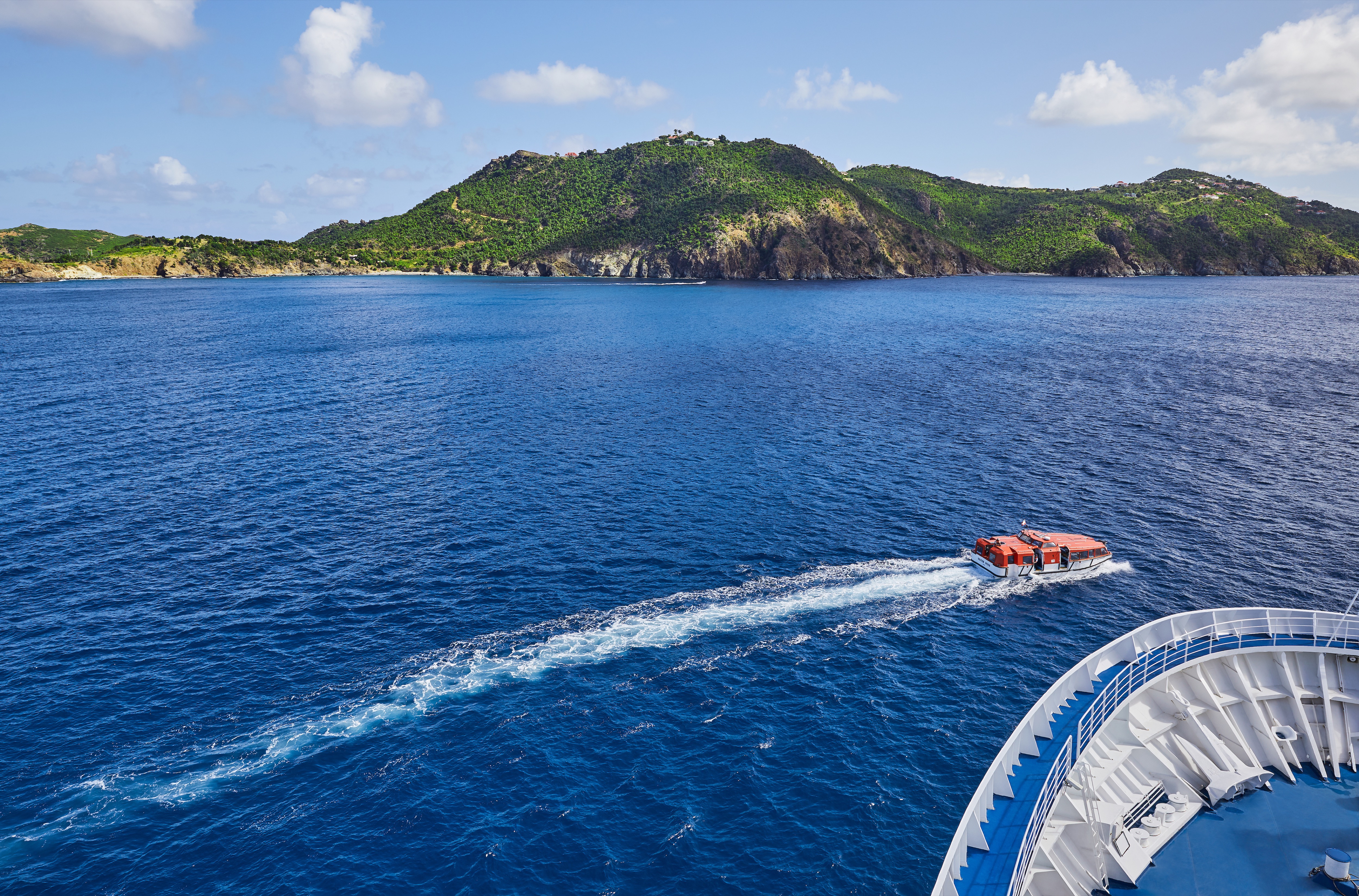
Mid-Voyage Adventures
Multiple days at sea mean plenty of R&R for some, but others prefer to experience all there is to offer on land. Our Mid-Cruise Land Adventures allow you to take full advantage of your time with us without missing a single thing! These short escapades offer an array of adventures, break up your sea days and allow for deeper exploration beyond the coast.
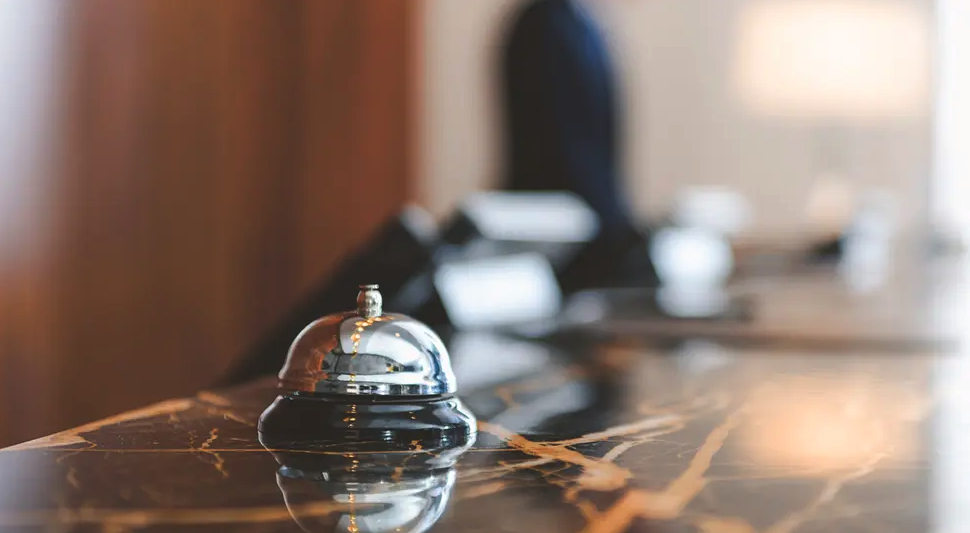
Silver Shore Excursions
Let Silversea customize a special event or excursion exclusively for you. Expert Shore Excursion professionals are available to assist with all your Shorex questions. Make an appointment and gain insider access to knowledgeable suggestions, personalized planning and hassle-free coordination of all private, independent touring, including area highlights, flightseeing, water sports, and much more. Take advantage of this service either in advance of your voyage by email at shoreconcierge@silversea.com or on board by visiting the Silvershore® Concierge desk. Have the Silver Shore Concierge create your tailor-made tour, or be whisked away by private car for a day—the pace and agenda are up to you.
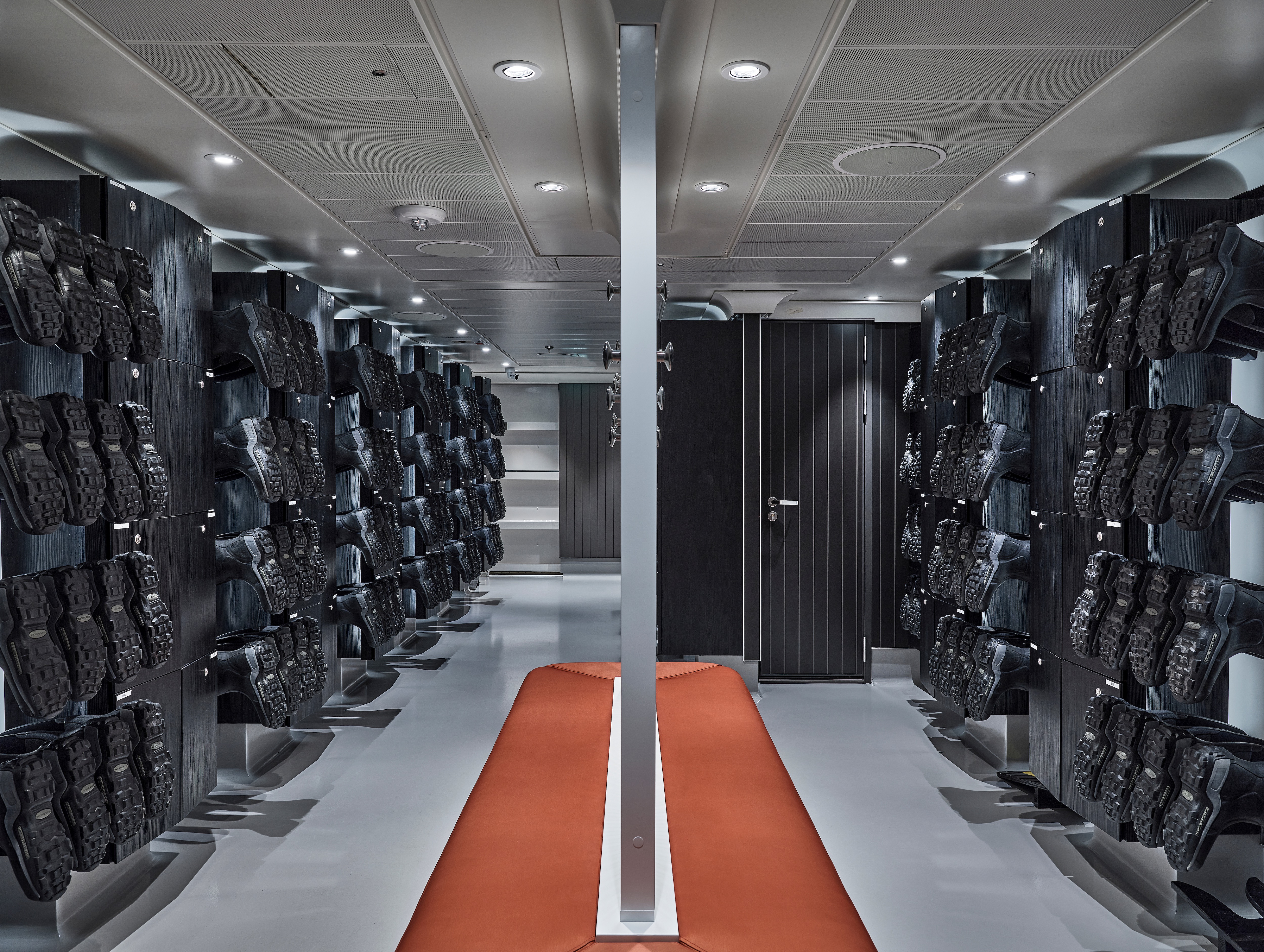
Mud Room
Silver Endeavour’s Mud Room is the perfect place to prepare for all your expedition activities. Spaciously designed, the two mud rooms (both port and starboard locations) are superbly modern and equipped with state-of-the-art equipment, including boot heaters and LED screens for small-group briefing sessions. Located on deck 3, the Mud Room leads directly to the landing platform for easy access for Zodiac embarkation and disembarkation.
Images are intended as a general reference. Features, materials, finishes and layout may be different than shown.
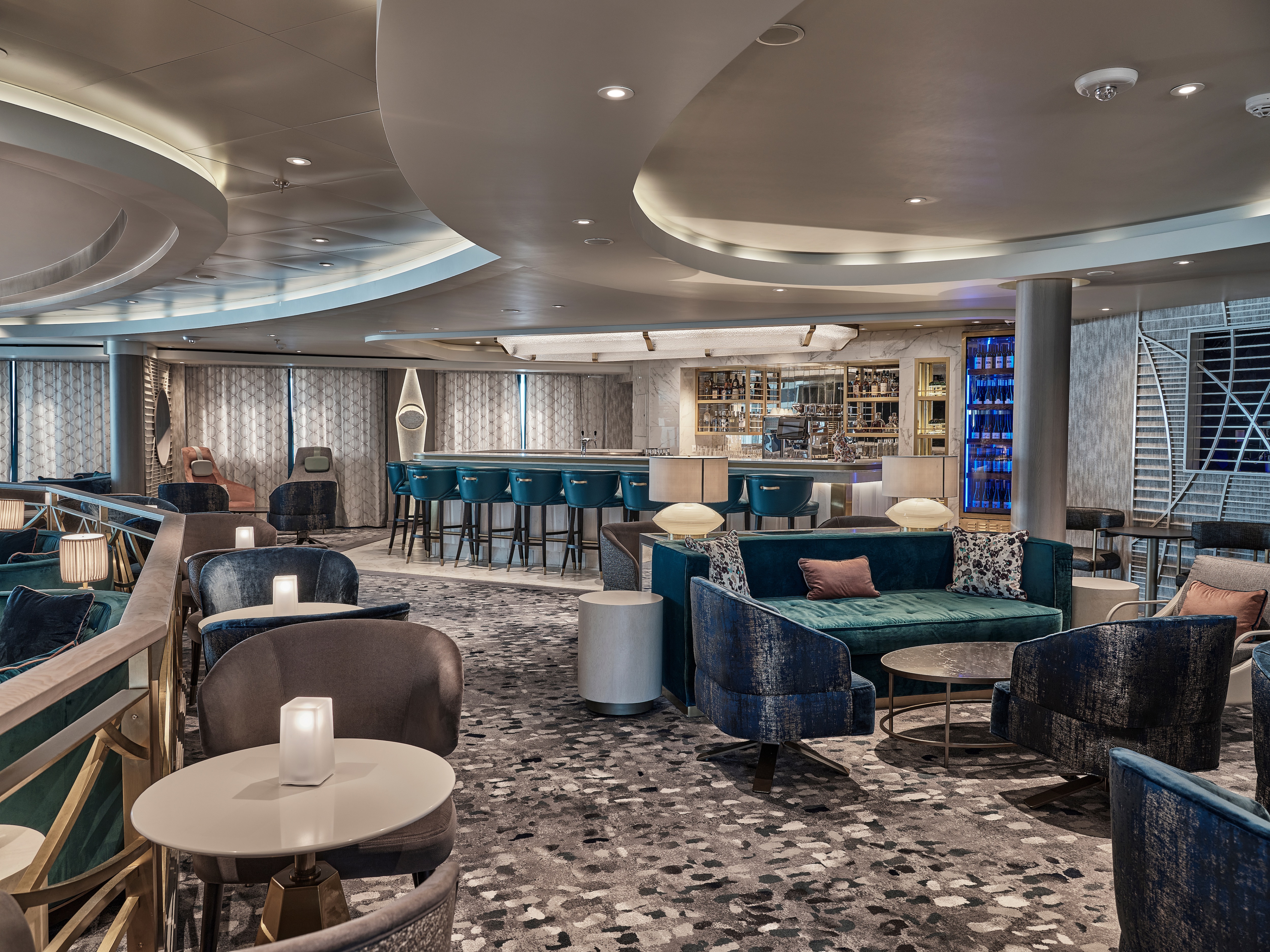
Explorer Lounge
Strategically located midship on deck 4, the Explorer Lounge is the operational heart of shore excursions while on board. Equipped with state-of-the-art equipment, including large LED screens, this is where you’ll attend your daily recap and briefing sessions, chat with our industry-leading Expedition Team, or attend lectures that delve deep into the history, flora, and fauna of your destination. It is also the perfect place to gather for pre-dinner cocktails or evening events such as the Captain’s Welcome.
Images are intended as a general reference. Features, materials, finishes and layout may be different than shown.

Library
Whether you’re an avid bibliophile or simply prefer a quiet place while at sea, it’s hard not to fall in love with Silver Endeavour’s onboard library. Located on deck 9, the Library offers a comfortable and intimate enrichment space, where you can educate yourself from one of the beautiful reference books, curl up with a novel in one of the comfortable chairs, or simple gaze amazed at the stunning scenery as its floats serenely by.
Images are intended as a general reference. Features, materials, finishes and layout may be different than shown.
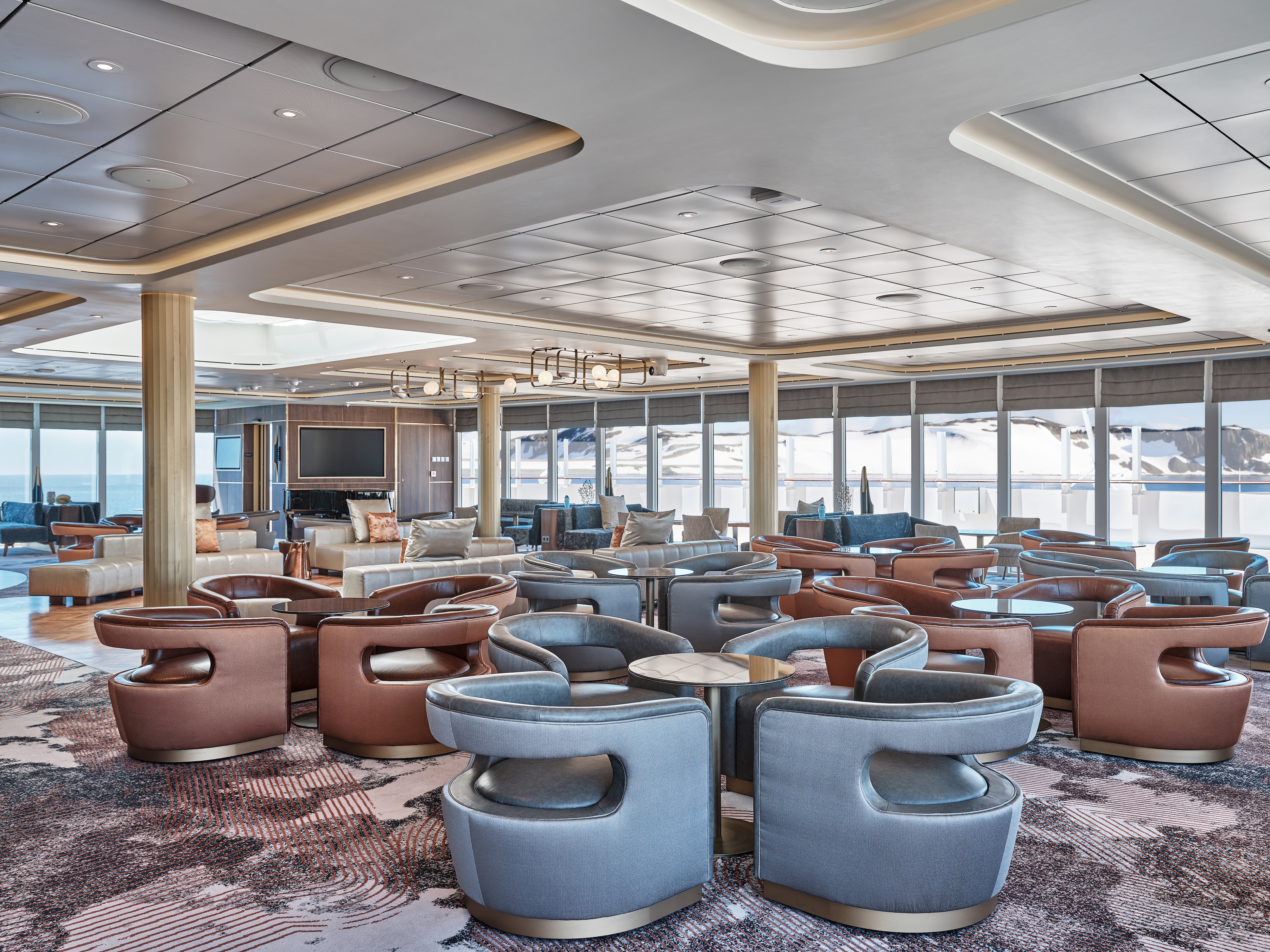
Observation Lounge
Located at the very top of the ship, the Observation Lounge offers one of our favorite vantage points on board Silver Endeavour. Comfortable seating, plus 270-degree surrounding glass windows make this immersive venue ideal at any time of the day. Offering very spacious interiors, the Observation Lounge is the perfect place to enjoy afternoon tea, an enrichment presentation by day, or pre-and post-dinner cocktails by night. Join your fellow travelers and discuss the day’s events while listing to some live entertainment in this fabulous venue.
Images are intended as a general reference. Features, materials, finishes and layout may be different than shown.
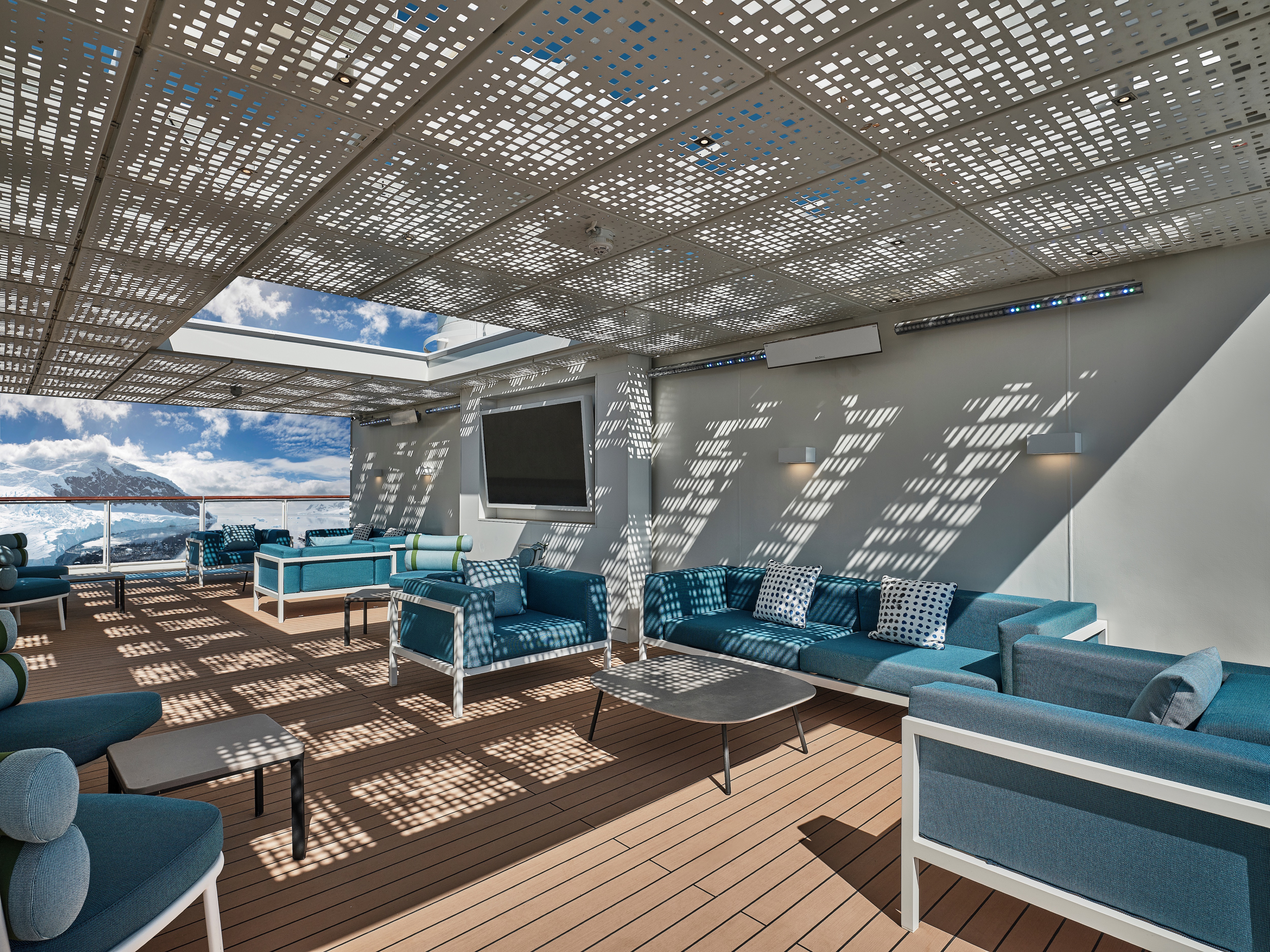
Sun Deck
The ocean views and soothing sound of the surf can be quite intoxicating at sea, so it’s not surprising that daydreaming on deck is one of the most popular pastimes.
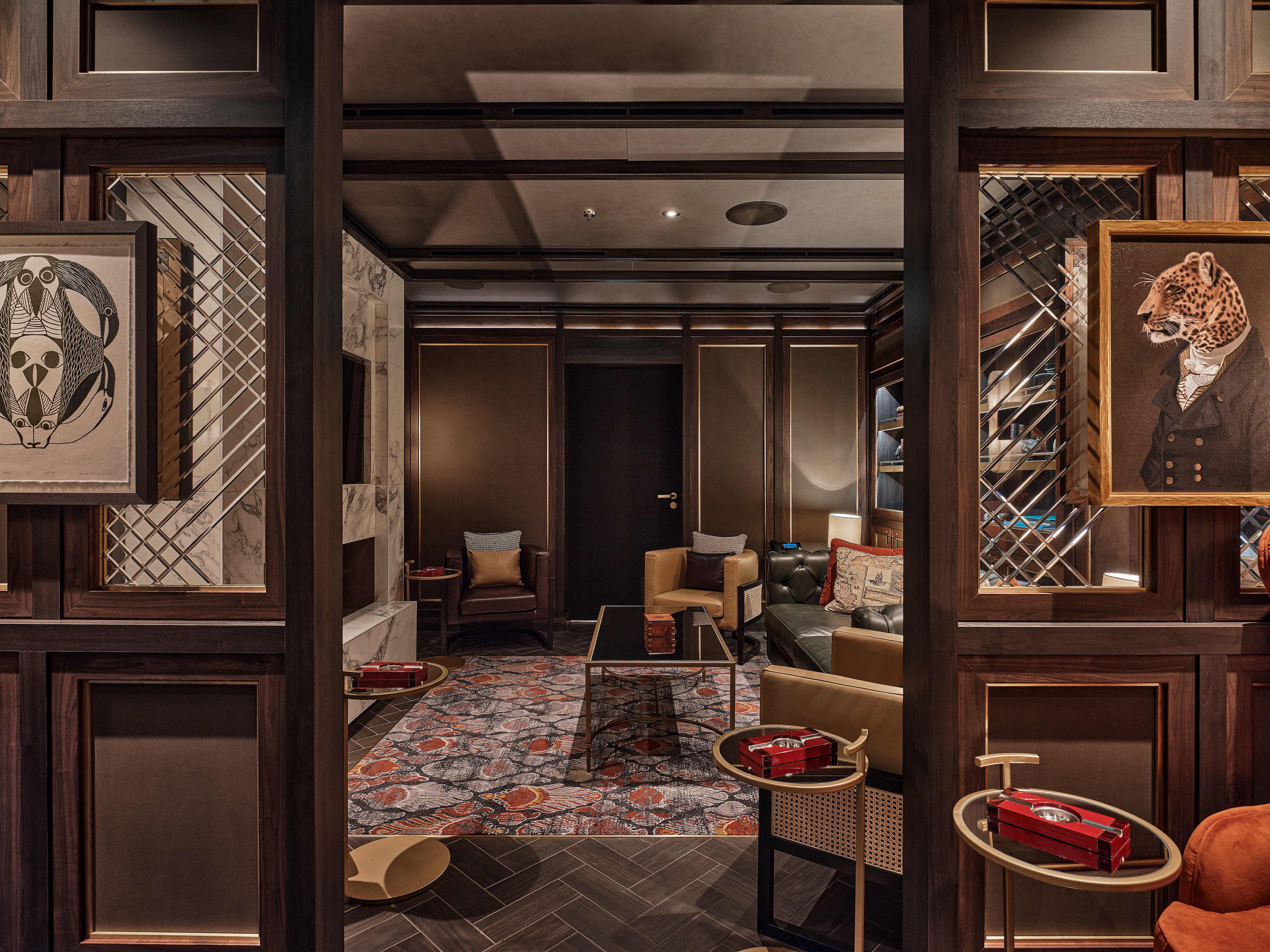
Connoisseur's Corner
The Connoisseur’s Corner is an indulgent and sophisticated cigar lounge, where you can enjoy an after-dinner drink in a cozy private club atmosphere. Soak up a wide selection of premium spirits, classic cocktails, and modern concoctions, or order from the exclusive cigar menu. This beautiful heritage venue with a contemporary twist, complete with armchairs, a cozy fireplace, and a humidor, make this is an incredible place to visit after dinner.
Images are intended as a general reference. Features, materials, finishes and layout may be different than shown.
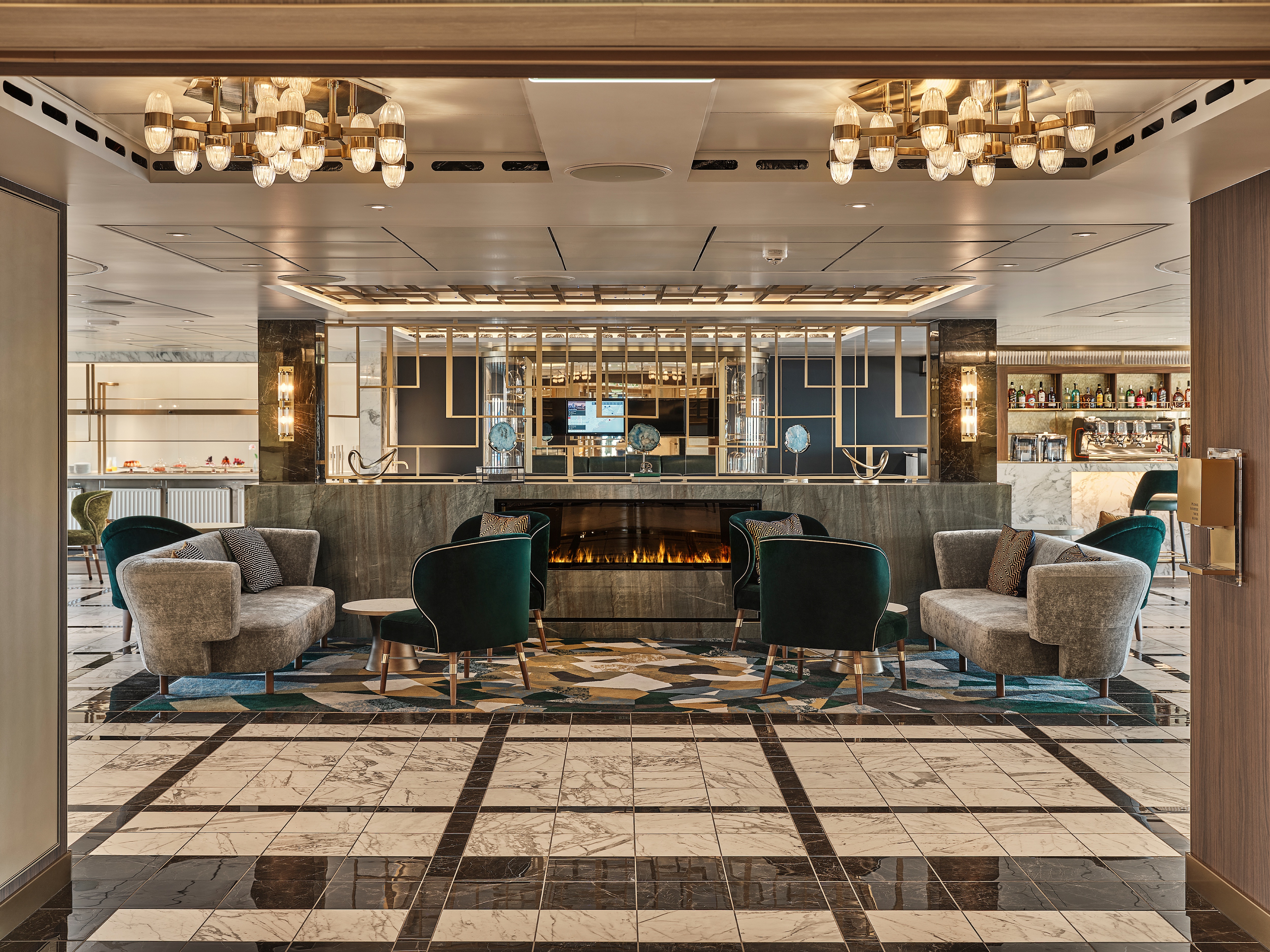
Arts Café
Silver Endeavour’s friendly, luxury Arts Café delivers gourmet treats, outstanding coffee, and healthy refreshments from morning to early evening. This is the perfect destination for cold and hot drinks, sandwiches, salads, as well as cakes and small-plate servings. Savor a delightful drink and fusion of flavors while enjoying magnificent views thanks to floor-to-ceiling glazing. If you’re looking for a quiet place for a bite to eat while you catch up with your fellow travelers, then why not visit the Arts Café on deck 5?
Images are intended as a general reference. Features, materials, finishes and layout may be different than shown.
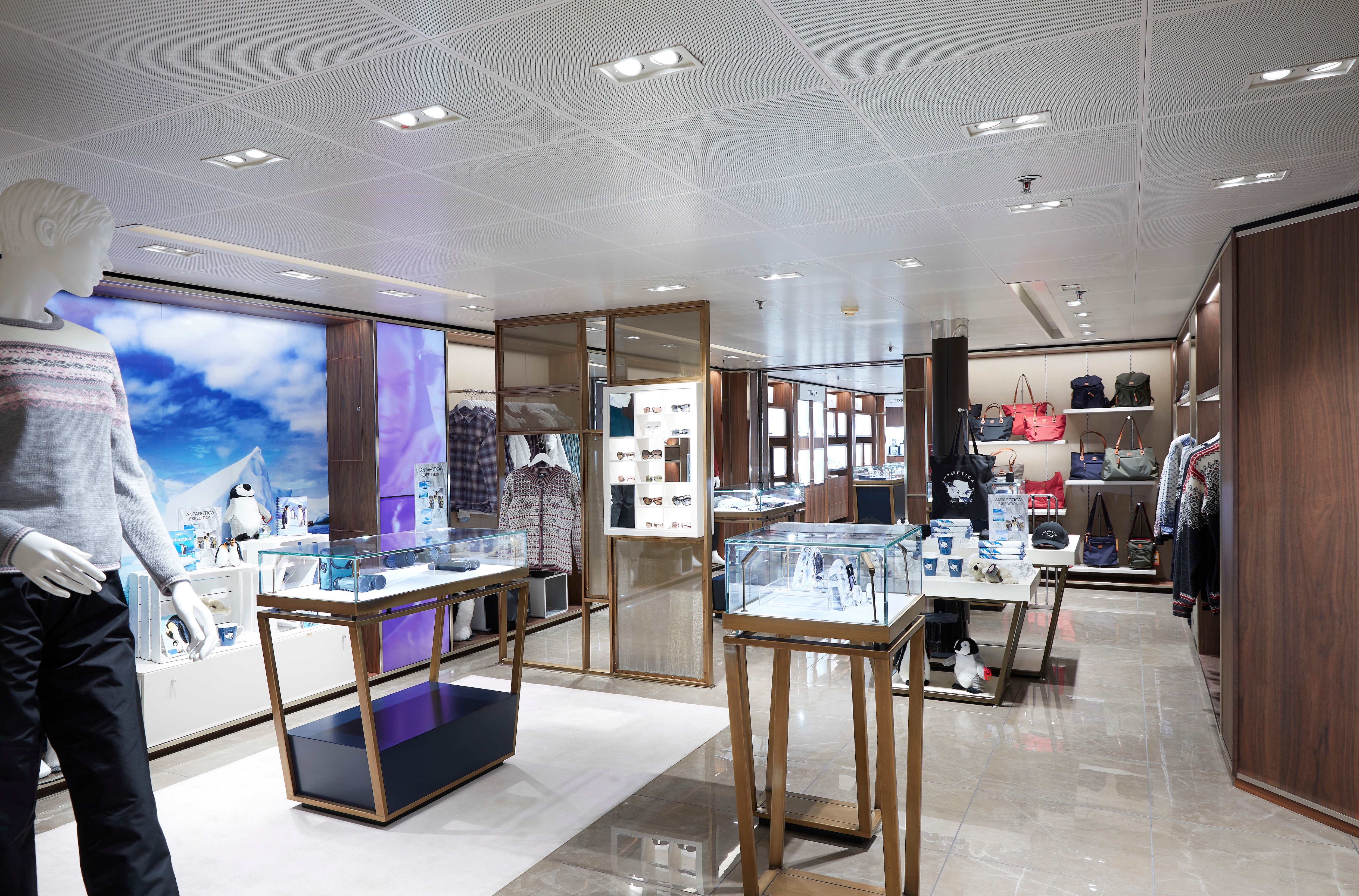
Boutique
Located midship on deck 5, the Boutique aboard Silver Endeavour means luxury shopping experiences do not end just because you’re at sea! Carefully selected partners offer a wide selection of the latest fashions (including a great selection of tote bags) plus jewelry, logo items, and souvenirs carefully selected to complete your expedition experience.
Images are intended as a general reference. Features, materials, finishes and layout may be different than shown.
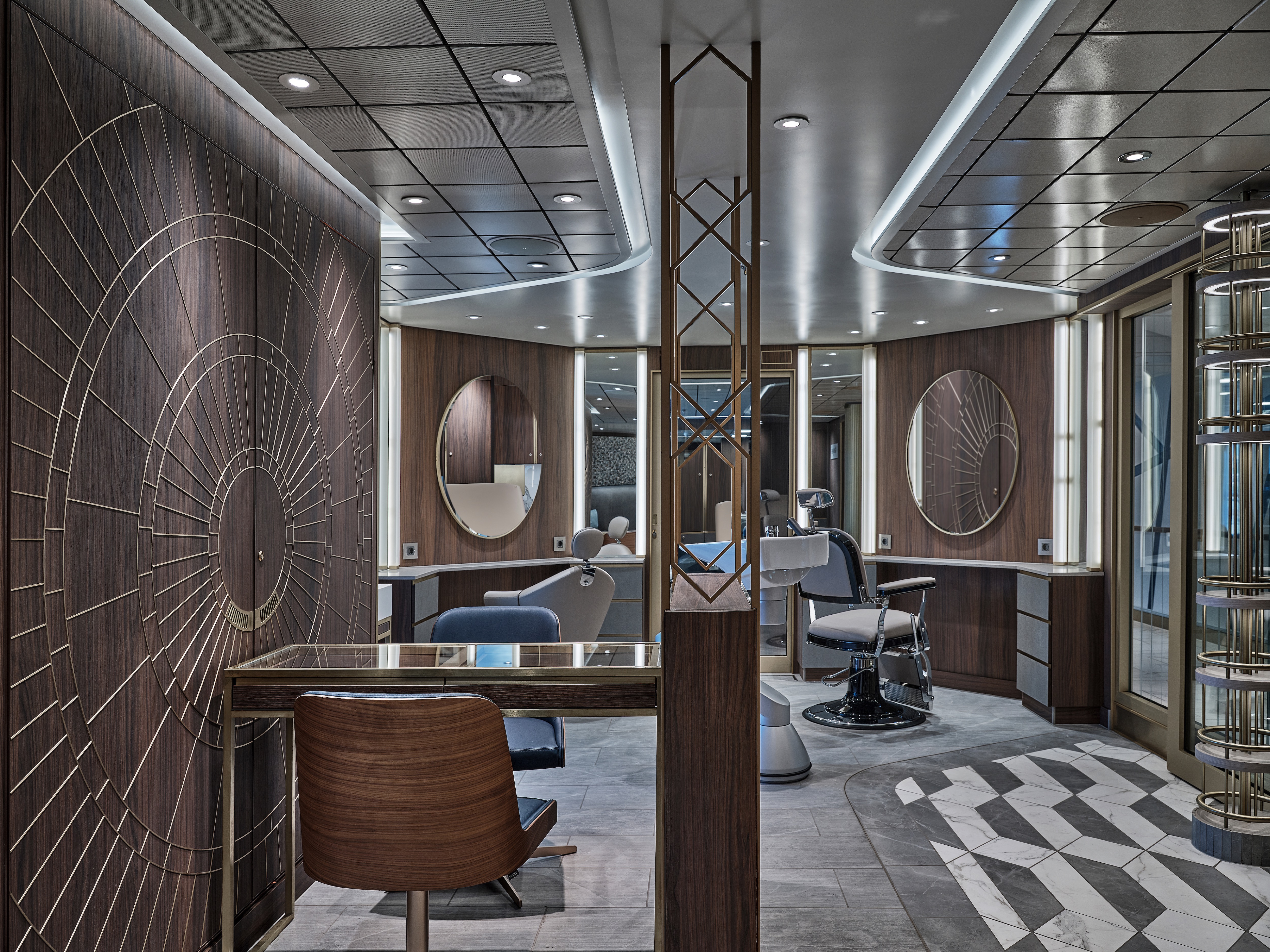
Beauty Salon
Our committed and competent team of beauty therapists is here to help keep your hair, nails, skin, and body healthy and happy. In addition to our regular beauty services, such as pedicures, manicures, and the latest in trendy hairstyles, we offer makeup application so you look great on a special evening, waxing, and teeth whitening. What’s more, our Emperor’s Chair services make sure that gentlemen aren’t forgotten.
Images are intended as a general reference. Features, materials, finishes and layout may be different than shown.
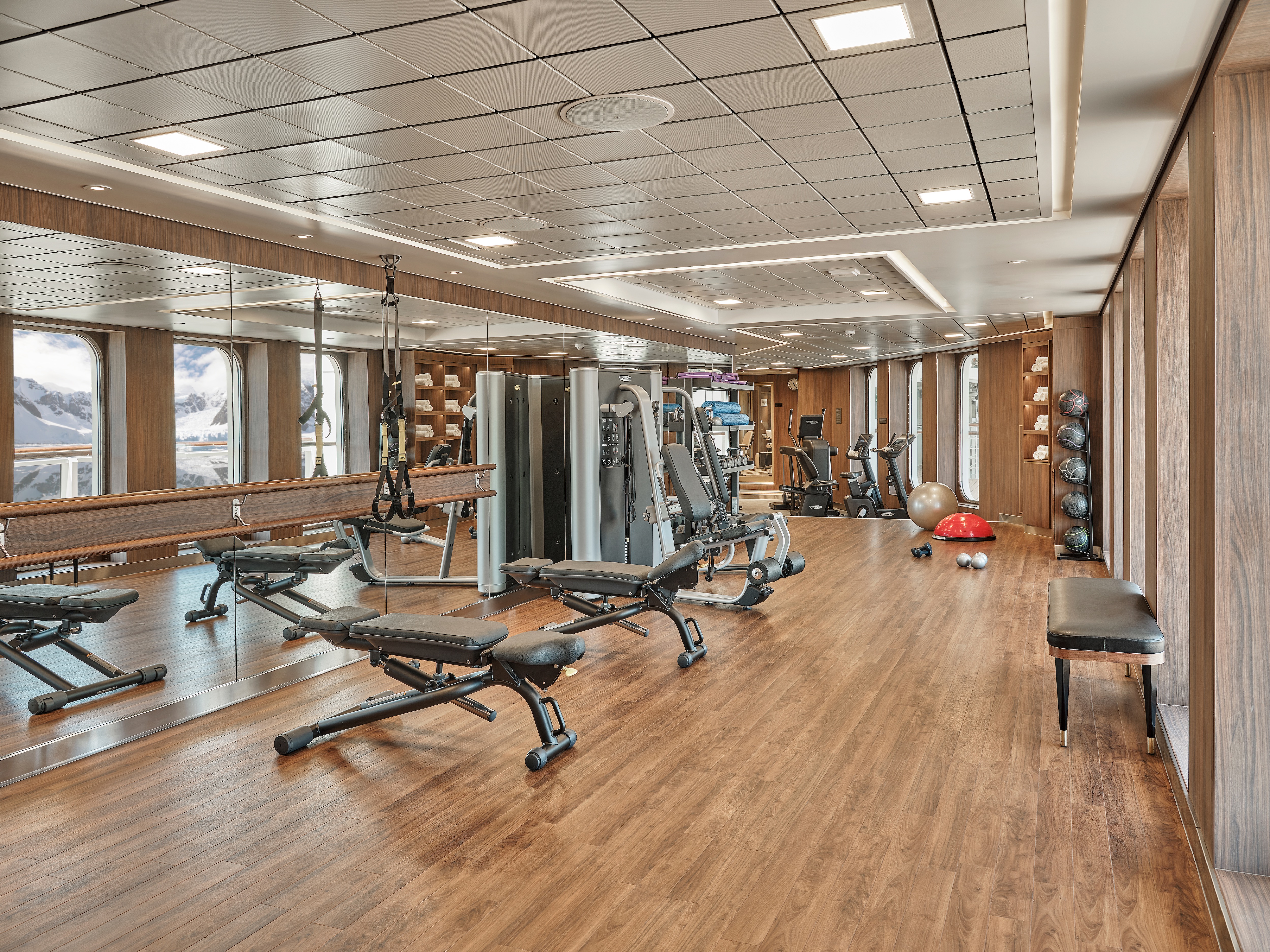
Fitness Centre
Whether you are a serious fitness fanatic or a casual athlete, you’ll find what you’re looking for in Silver Endeavour’s Fitness Center. Look after your health with our cardiovascular equipment, including running and cross-country skiing machines, free and plate-loaded weights, weight machines, and plenty of warm-up/cool-down spaces. Expertly designed classes and personal training sessions make sure that you stay in shape even while at sea. Thanks to its modern design with floor-to-ceiling windows, the Fitness Center enjoys an incredible amount of natural light and views of the destination, so you won’t miss any part of the action.
Images are intended as a general reference. Features, materials, finishes and layout may be different than shown.
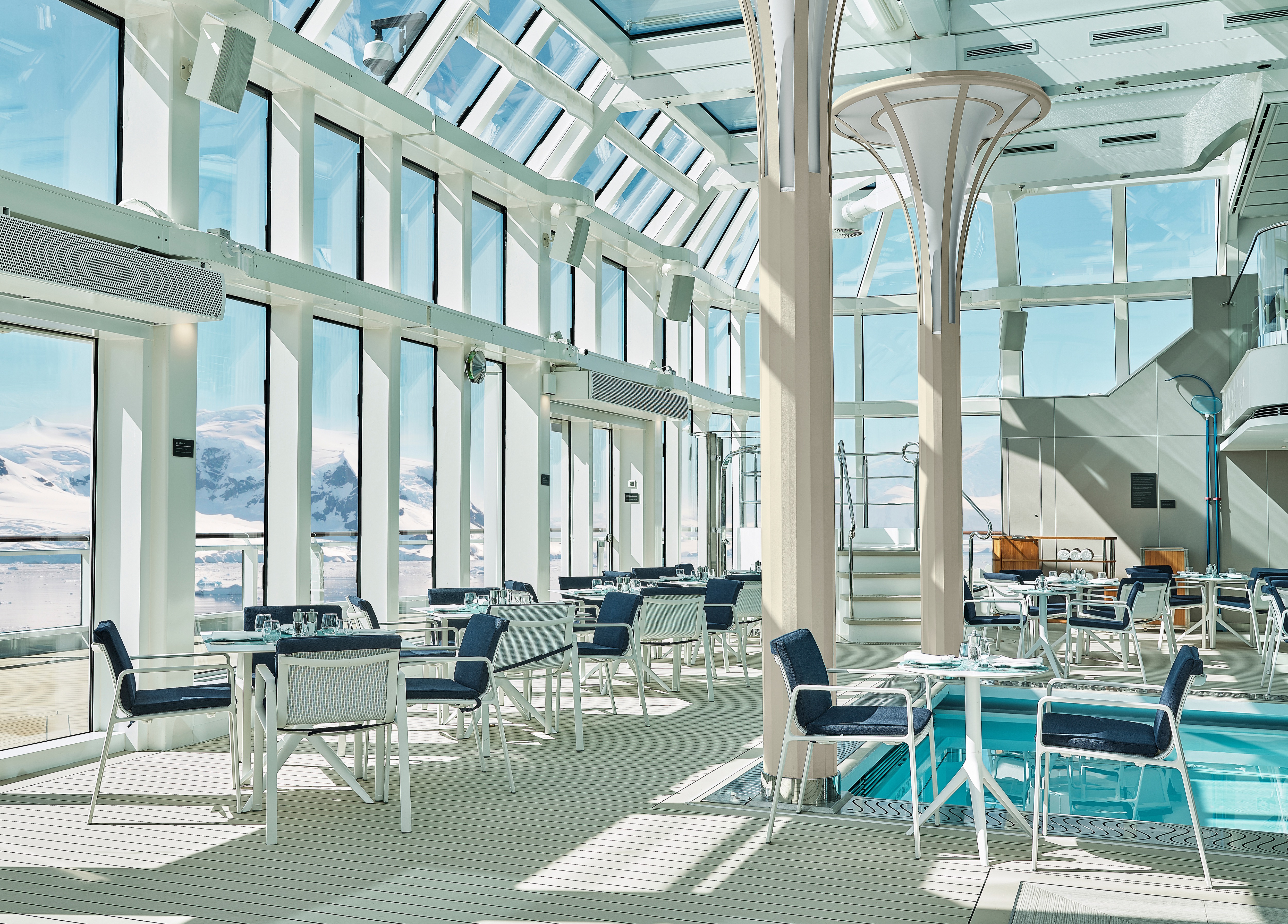
Pool Deck
Surrounded by glazing extending all the way to the top of the venue, the Pool Deck gives you the feeling of always being connected to the sea. The glass-enclosed Pool Deck offers a quiet retreat and is the ideal place to enjoy breathtaking, panoramic views during the day, or to have dinner under the stars at night. This two-story space is home to a large central pool, a whirlpool, as well as Silver Endeavour’s The Grill restaurant.
Images are intended as a general reference. Features, materials, finishes and layout may be different than shown.
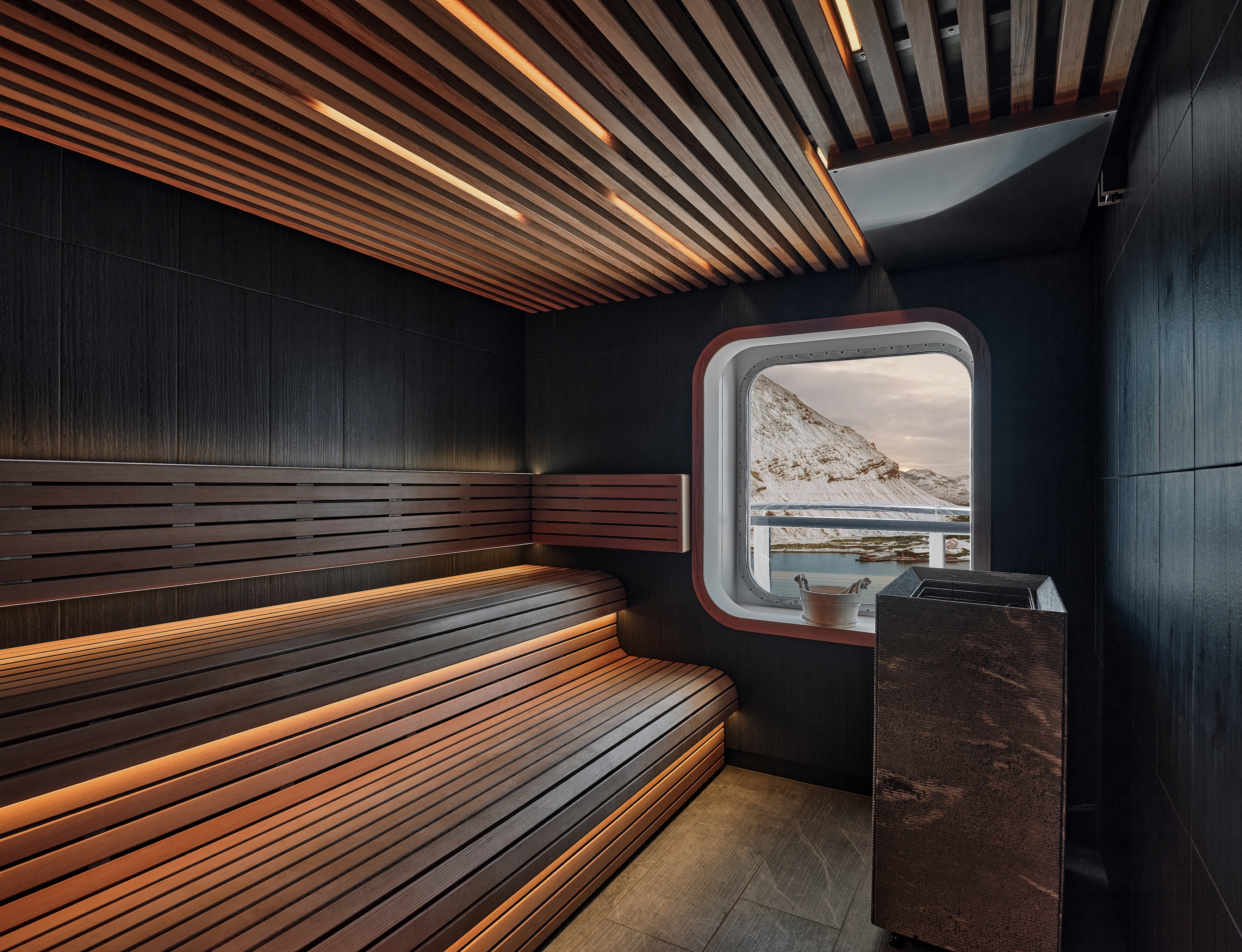
Otium Spa
Otium is where you can relax and unwind but also where you can enjoy world-class treatments that make sure you look as good as you feel. Our Otium wellness menu is designed by our experts to create signature moments that even Venus herself would envy. Rejuvenate and repair with one of our luxury treatments, or visit us to relax and unwind, share a moment with like-minded travelers, or enjoy a quiet immersive session all for yourself.
Images are intended as a general reference. Features, materials, finishes and layout may be different than shown.
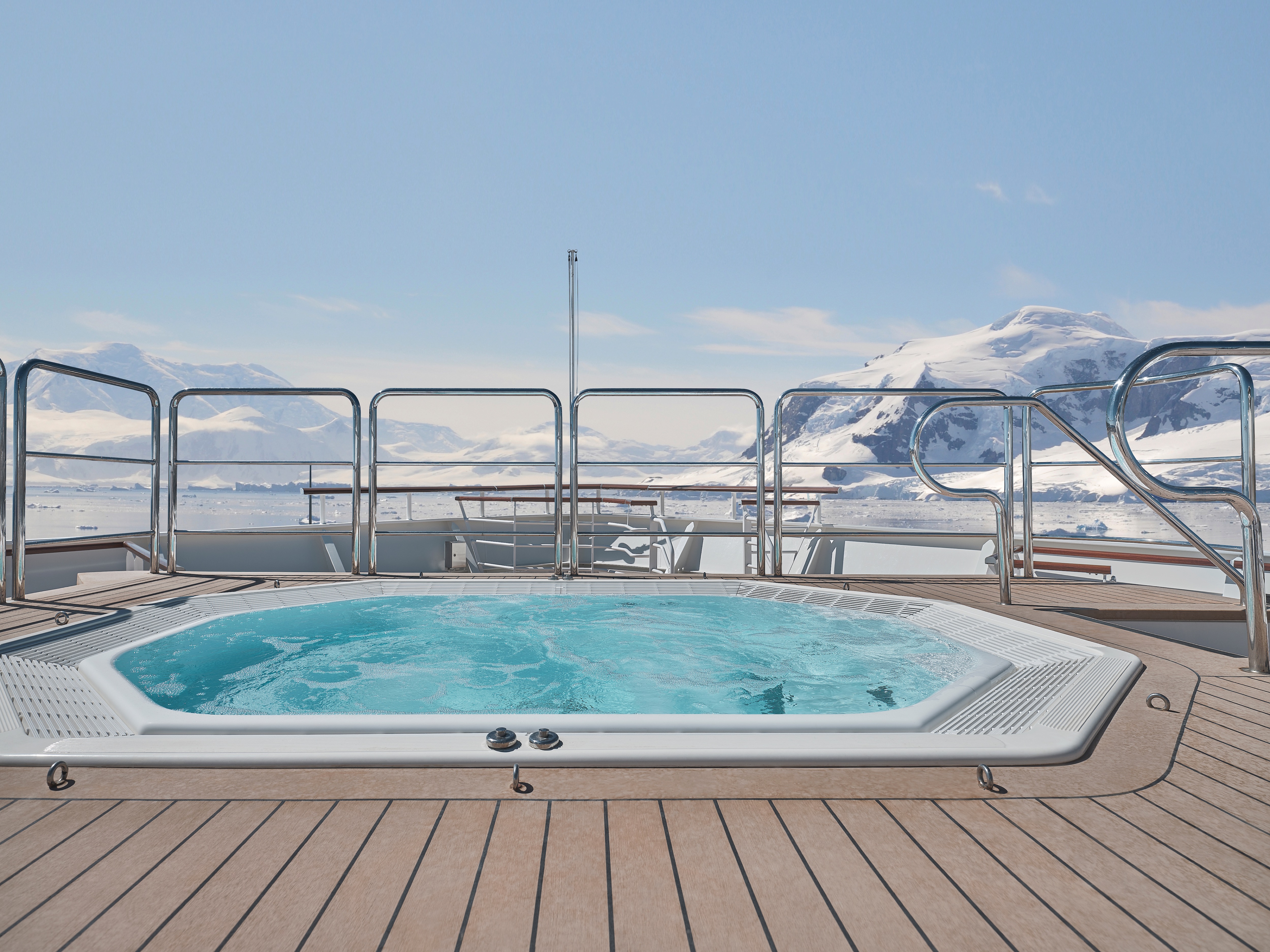
Whirlpool
You can find the whirlpool on Deck 5, next to the Pool and The Grill.
Smoking Policy
At Silversea, the comfort, enjoyment and safety of all guests is paramount. To ensure a pleasant and safe environment, smoking is prohibited in most public areas, guest suites or suite balconies. However, cigarette, e-cigarette, cigar, pipe and vaporizer smoking is permitted in the Connoisseur’s Corner both indoors and outdoors (where applicable). In addition, cigarette, e-cigarette and vaporizer smoking is permitted in specifically designated outside areas and tables:
- Silver Nova, Silver Ray: Dusk Bar (port side);
- Silver Muse, Silver Spirit: Panorama Lounge (port side) and Pool Grill (port side);
- Silver Moon, Silver Dawn: Panorama Lounge (starboard side) and Pool Grill (port side);
- Silver Shadow, Silver Whisper: Panorama Lounge (starboard side) and Pool Grill (starboard side);
- Silver Cloud, Silver Wind: Panorama Lounge (port side) and Pool Grill (port side);
- Silver Origin: on open deck 4 aft;
Silversea kindly requests that all guests observe the non-smoking areas.
Medical Centre
Each Silversea ship is equipped with a Medical Centre, which is staffed by a doctor and nurse on 24-hour call when at sea. When docked, supplementary emergency care may also be obtained through local medical facilities. Guests may be charged for medical services and for medications used for their medical treatment. The Medical Centre is not intended or designed to provide on-going treatment of pre-existing conditions or for extended critical care, and Silversea is not responsible for the diagnosis, treatment or services furnished by shipboard medical personnel.
All guests are required to report in writing to Silversea at the time their reservation is made:
- Any physical or mental condition that may require medical or professional treatment or attention during the voyage
- Any condition that may render the guest unfit for travel, or that may require special care or assistance
- Any condition that may pose a risk or danger to the guest or anyone else on board the ship
- Any condition that may require oxygen for medical reasons
- Any intention or need to use a wheelchair aboard ship.
Special Dietary Requirements
If you have special dietary requirements, Silversea will make every attempt to accommodate your requests. Please advise Silversea of your needs on the Guest Information Form at least 75 days prior to sailing. Notification should be sent to specialservices@silversea.com
Disabled Facilities
Wheelchair guests must bring their own collapsible wheelchair. Please note that not all shore excursions are suitable for guests with impaired mobility. Silversea strongly recommends wheelchair guests travel with someone who is able to assist them both ashore and at sea as Silversea may be unable to offer special assistance. Please note that wheel-on and/or wheel-off access may not be available at some ports-of-call. Silversea reserves the right to deny boarding to any guest who failed to notify Silversea of such requirement at the time of booking.
Silversea welcomes guests with mobility needs and offers various accessibility features onboard. However, due to the nature of cruising, some destinations and excursions may present challenges. Below is a guide to help guests plan their journey.
BEFORE BOOKING
Do guests need to notify Silversea in advance about mobility needs?
Yes, guests should inform Silversea of any special assistance or mobility equipment requirements before sailing. This can be done via My Silversea under Guest Information / Special Request, or by contacting specialservices@silversea.com.
Does Silversea provide wheelchairs?
Yes, each vessel has wheelchairs available at the reception for temporary use, such as embarkation and disembarkation. Guests who require a wheelchair for the entire cruise should bring their own.
Can guests bring their own mobility equipment?
Yes, personal wheelchairs, scooters, and other mobility aids are allowed. However, guests staying in standard (non-ADA) suites should note that electric scooters may not fit through the doors.
Therefore, guests traveling with a wheelchair, scooter, or ECV are always highly suggested to book a wheelchair-accessible suite with a wider entrance door and an appropriate path of travel inside the room and accommodate the equipment. Regular Suites have a narrower entrance door and may not have the necessary interior space to accommodate wheelchairs and scooters.
What features do wheelchair-accessible suites offer?
Silversea ships offer specially designed suites for guests who require mobility assistance. These suites are equipped with wider entrance doors and appropriate paths of travel to accommodate wheelchairs, scooters, and other mobility equipment. All areas within these suites are reachable without the need for additional ramps, except for Silver Suites onboard Silver Moon and Silver Dawn and Classic Veranda onboard Silver Endeavour. In these suites Silversea offer ramp to go outside the balcony. The vessels also have wheelchairs available at the reception for guest use.
Where to find the information regarding the disabled access suites?
This information is visible under the Suite tab by suite category.
Also, can be found on the deck plan after clicking on the “View Deck Plan” tab on the ship page. The disabled access suites are indicated with the universal accessibility icon.
EMBARKATION & DISEMBARKATION
How do guests get on and off the ship with mobility equipment?
Silversea vessels have procedures in place to assist guests with mobility equipment during embarkation and disembarkation. When the gangway is flat, guests can drive their wheelchair off the ship. However, if the gangway involves stairs, our staff will provide assistance. The Safety Officer or Bridge must be informed whenever a wheelchair is involved in disembarkation or boarding, and our crew members are available to assist guests in need.
Is assistance available for boarding?
Yes, but guests who require full-time assistance should travel with a companion, as Silversea does not provide dedicated personal caregivers. Butlers can assist with getting to the gangway or dining venues but do not provide continuous mobility assistance.
ONBOARD
Silversea’s ships are designed for accessibility, featuring:
- Wide gangways to accommodate most wheelchairs and scooters
- Accessible public restrooms
- Wheelchair seating in dining venues, bars, and the Venetian Lounge
- Braille/tactile signage for visually impaired guests in elevators, stateroom numbers, and staircases
How does Silversea assist disabled guests in their suites?
Silversea butler can provide reasonable assistance to guest getting to and from the gangway, and to and from a restaurant, however Silversea does not offer full-time wheelchair service and/or staff fully dedicated to providing Guests with wheelchair assistance. Guests traveling on their own wheelchair should be assisted only when requested and are recommended to travel with an able bodily companion.
GOING ASHORE
Are all ports wheelchair accessible?
Not all ports have wheelchair-friendly infrastructure. In some destinations, tender boats or on Silversea Expeditions Zodiacs are required for disembarkation, and wheelchairs or mobility scooters cannot be accommodated in these cases.
Can guests arrange private accessible transportation in port?
If available, private wheelchair-accessible vehicles can be arranged. In some ports, shuttle buses may be wheelchair accessible, but availability is not guaranteed.
Does Silversea offer wheelchair-accessible shore excursions?
Until now we have been offering dedicated “Wheelchair Accessible Excursions” in some areas of the world., These tours are operated by wheelchair accessible vehicles and include only wheelchair accessible venues. These tours are mainly offered in Europe and the US. If you have any questions or concerns regarding shore excursion suitability, please contact the Shore Concierge (shoreconcierge@silversea.com) before your voyage or visit the Shore Concierge desk for more detailed information once onboard.
Wheelchair accessible shore excursions are indicated on the website with the universal accessibility icon.
Are there alternatives for guests with limited mobility?
In almost every port, Silversea offers low-activity excursions specially designed for mobility challenged guests, who can negotiate the steps on and off the coaches.
Is there any destination that is not recommend to guests with disabilities?
The more exotic destinations, like Asia, South Africa and South America it is recommended to guest to book a private vehicle due to the lack of infrastructure, for example wheelchair accessible vehicles are very rare to find and museums, restaurants and popular attractions are not often completely accessible.
Does Silversea offer wheelchair-accessible transportation between the ship and visiting site?
If available in the port yes, however this is not often available.
How Silversea assist disabled guests during excursions?
If wheelchair accessible excursions are not available, it is recommended to guests to book a private vehicle where they can have a dedicated guide and driver who can give them full attention. On regular shore excursions, the guide must look after all guests and may not be able to fully assist disabled guests.
Laundry
Complete valet services, including laundry, pressing and wet cleaning, are available at an additional charge and may be arranged through your butler. Laundry service is complimentary on higher category suites (Premium Medallion, Medallion, Silver, Royal, Grand, Junior Grand, Signature, Master, Otium and Owner’s Suites) and for those Venetian Society members who have reached certain reward levels. click here to learn more. A self-service laundromat offers washing machines, dryers, irons and laundry supplies, allowing you to limit the amount of cruise luggage needed, especially for longer voyages.
Wi-FI & Internet
All Silversea ships are equipped to offer wireless (Wi-Fi) Internet access. You can use your own laptop to surf the Internet and check emails at Wi-Fi locations throughout the ship, or from the comfort and privacy of your suite. Computers, email and Internet access are also available on board at the Internet Café. However, it is important to understand that telecommunication services while at sea are via satellite and significantly different than high-speed connections on land back home. The signal travels in a similar manner to radio waves but at much greater distances. Therefore, onboard Internet access is not guaranteed at all times. Satellite communications are also affected by weather and the ship’s location. In particular, Internet service is extremely sporadic while in the Arctic. Guests aboard expedition cruises to/from Svalbard should be prepared to be out of communication for the duration of their time on board.
Onboard cell phone service enables you to make and receive phone calls, text messages and other select data services on your cell phone even when miles away from land. Your cell phone service provider will bill you for calls and/or messages, which may appear as roaming charges. Please note that cell phone service is sporadic at best while in the Arctic. Guests aboard voyages to/from Svalbard should be prepared to be out of communication for the duration of their time on board. Click here for more information on Silversea’s Cellular Phone service.
Will my devices work on board?
To be most successful, prepare your devices BEFORE leaving home:
- Learn how to turn ON and turn OFF both the Wi-Fi and network (mobile/cellular) connections on each of your devices.
- Contact your mobile/cellular service provider to confirm that a roaming agreement with Silversea Cruises has been established and to ask about rates. Learn how to enable your international roaming
- Set up an email account if you do not have one already.
- Be sure you know any usernames and passwords you may need.
- Switch your settings to the most basic choice that shows less graphics and loads faster.
- Make any software updates and turn off any automatic update settings for the duration of your cruise.
- Download any books, audiobooks, music, movies, games, apps, etc. that you may want during your cruise.
- Facebook users should bookmark and plan to use M.Facebook.com or Touch.Facebook.com instead as these have less graphics and load faster.
- Don’t forget to pack any power cords/battery packs, camera cables to transfer pictures, adapter cables and headphones you may need for each of your devices.
Will I be able to download videos and stream music?
Certain websites and services may be restricted due to limited bandwidth. Downloading videos, books and movies or using Skype are examples of high-bandwidth services that will be more frustrating than enjoyable and should be avoided. Plan to use the Internet only for emailing and web browsing.
How can someone contact me on the ship?
In the case of an emergency back home, friends and family should not call your cell phone. The Shore-to-Ship number provided in your Final Cruise Documents is the best way to reach you while aboard ship. Click here for more information on Dial A Ship service, an alternate option for contacting ships at sea, anywhere in the world.
Age Restrictions
Silversea cruise guidelines state that children under the age of 18 must be accompanied, in the same or connecting suite, by a parent or other responsible adult over the age of 21 for the duration of the voyage. If the adult accompanying the minor is not their parent, a parental consent guardianship form must be signed by a parent or legal guardian and received by Silversea prior to sailing. Please contact our Special Services Department at SpecialServices@Silversea.com for a Parental Consent Form. Guests must be 21 years of age or older to purchase or consume alcohol. Silversea reserves the right to refuse to serve anyone who in its sole judgment may be under the influence of alcohol, or for any reason necessary in its judgement to preserve the health and safety of guests and employees.
Silversea cannot accommodate infants less than six months of age and reserves the right to limit the number of children less than three years of age (Silver Explorer, Silver Cloud and Silver Wind cannot accommodate infants under the age of 1 year, Silver Origin cannot accommodate children under the age of 5 years). Parents are required to sign a notarised waiver prior to sailing in order to grant a valid booking for children ages between 6 months and 1 year old. A signed and notarised waiver will be required for all children between these ages. Although Silversea accepts guests over the age of 6 months (over the age of 1 year for Silversea Expeditions), there are no special programmes for children on board our luxury cruise ships, and Silversea does not provide for the care, entertainment or supervision of children. Silversea reserves the right to limit the number of children less than 3 years of age.
Children under the age of 8 years old are only permitted to participate in suitable Silver Shore Excursions / shuttle service if the vehicles are equipped with the correct safety harness and seating equipment. Child harnesses and secure seating cannot be guaranteed. Silversea reserves the right to refuse children under the age of 8 years old on any tour on the basis of safety. Guests may use their own approved safety seat, booster seat or harness provided they are compatible with the local touring vehicle and can properly secure the child.
In addition, the Zodiacs used for Silversea Expeditions are unable to accommodate children younger than 5 years of age. As Silversea does not provide babysitting services, an adult family member will be required to remain on board with their child(ren) during Zodiac excursions.
Dress Code
How many formal nights are on my cruise, and what type of clothing is worn?
Find out what to pack. All the details are shown in the General Information section. For Silversea Expeditions guests, casual resort wear is appropriate at all times when on board, with the exception of two evenings when formal attire is required. For men, this means a jacket, tie optional.
Does Silversea offer tuxedo rental service?
No, however, the onboard boutique has a limited selection of formal wear attire for purchase.

Deck 10
- Sun Deck

Deck 9
- Observation Lounge
- Library

Deck 8
- Master Suite
- Superior Veranda Suite
- Signature Suite
- Silver Suite

Deck 7
- Owner’s Suite
- Grand Suite
- Premium Veranda Suite
- Deluxe Veranda Suite
- Superior Veranda Suite

Deck 6
- Whirlpool
- The Bow
- Classic Veranda Suite
- Premium Veranda Suite
- Superior Veranda Suite
- Deluxe Veranda Suite

Deck 5
- Classic Veranda Suite
- Arts Café
- Beauty Salon
- Reception
- Future Cruise Sales
- Fitness Centre
- Otium Spa
- Boutique
- Pool Deck
- The Grill
- Whirlpool

Deck 4
- Medical Centre
- Explorer Lounge
- La Dame
- Connoisseur’s Corner
- II Terrazzino
- The Restaurant

Deck 3
- Mud Room
- Marina
- Launderette
